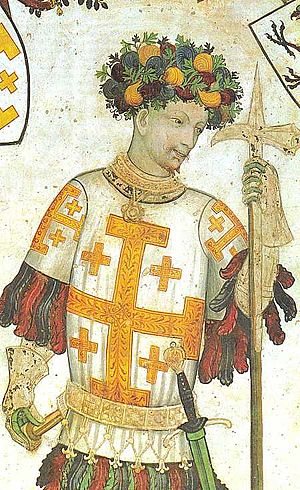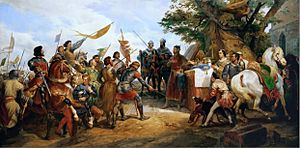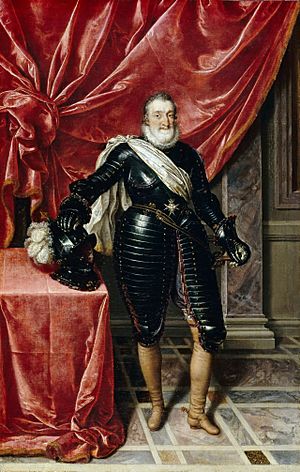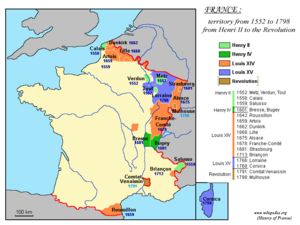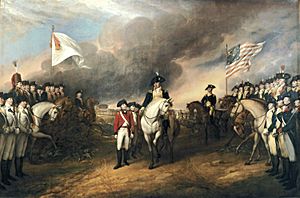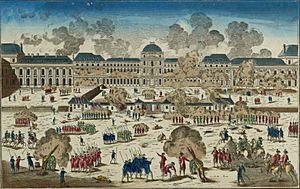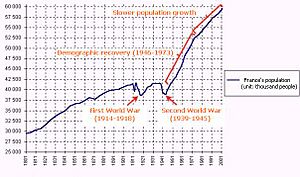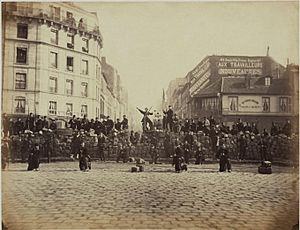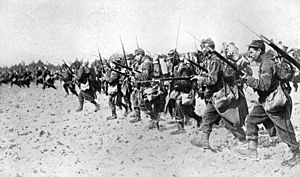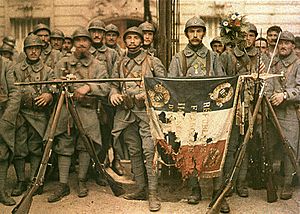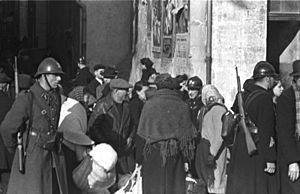History of France facts for kids
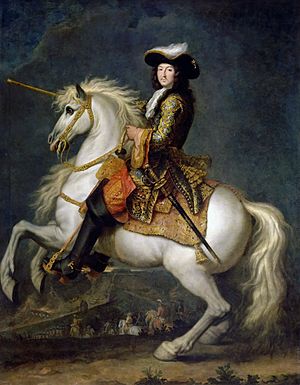
The story of France begins a very long time ago, in the Iron Age. Back then, the land we now call France was mostly known as Gaul by the Romans. Ancient Greek writers described three main groups of people living there: the Gauls, the Aquitani, and the Belgae. The Gauls were the largest group. They were Celtic people and spoke a language called Gaulish.
Around 1000 BC, Greeks, Romans, and Carthaginians started building settlements along the Mediterranean coast. The Roman Republic took control of southern Gaul in the late 2nd century BC. Later, Julius Caesar and his Roman armies conquered the rest of Gaul in the Gallic Wars (58–51 BC). After this, a mix of Roman and Gaulish cultures grew, and Gaul became a big part of the Roman Empire.
As the Roman Empire weakened, Germanic tribes, especially the Franks, moved into Gaul. The Frankish king Clovis I united most of Gaul in the late 5th century. This set the stage for the Franks to rule the region for hundreds of years. Frankish power was strongest under Charlemagne. The Kingdom of France later grew out of the western part of Charlemagne's empire, called West Francia. It became more important under the House of Capet, started by Hugh Capet in 987.
A problem with who would be king next happened in 1328. This led to the Hundred Years' War between the House of Valois and the House of Plantagenet. The war began in 1337 when Philip VI tried to take the Duchy of Aquitaine from Edward III of England. Edward also claimed the French throne. Even though the Plantagenets won early battles, like capturing John II of France, the Valois side eventually gained the upper hand. A famous hero from this war was Joan of Arc, a French peasant girl who led French forces against the English. The war ended with a Valois victory in 1453.
Winning the Hundred Years' War made French national pride stronger and greatly increased the power of the French kings. During the Ancien Régime (Old Rule) period, France became a powerful, centralized absolute monarchy. This happened through the Renaissance and the Protestant Reformation. During the French Wars of Religion, there was another crisis over who would be king. The last Valois king, Henry III, fought against the House of Bourbon and the House of Guise. Henry, the Bourbon King of Navarre, won and started the Bourbon family's rule. France also began building a worldwide colonial empire in the 16th century. The French king's power reached its peak under Louis XIV, known as "The Sun King."
In the late 1700s, the king and his system were overthrown in the French Revolution. France became a Republic for a while, until Napoleon Bonaparte created the French Empire. After Napoleon's defeat in the Napoleonic Wars, France had many changes in government. It was a monarchy, then a Second Republic, and then a Second Empire. Finally, a more stable French Third Republic was set up in 1870.
France was one of the Triple Entente powers in World War I against Germany. In World War II, France was one of the Allied Powers, but Nazi Germany conquered it in 1940. The Third Republic ended. Germany directly controlled most of the country, while the south was controlled by the Vichy government until 1942. Life was very hard, as Germany took food and people. Many Jewish people were killed. The Free France movement took over the colonial empire and led the Resistance during the war. After France was liberated in 1944, the Fourth Republic was created. France slowly recovered and had a baby boom. Long wars in Indochina and Algeria used up French resources and ended in defeat. After the 1958 Algerian Crisis, Charles de Gaulle started the French Fifth Republic. In the 1960s, most of the French colonial empire became independent. Smaller parts became overseas departments and collectivities of France. Since World War II, France has been a permanent member of the UN Security Council and NATO. It played a key role in creating the European Union. Even with slow economic growth recently, France is still a strong country in the 21st century.
Contents
- Ancient Times: Early People and Roman Rule
- Frankish Kingdoms: From Clovis to Charlemagne
- Building the Kingdom of France (987–1453)
- Early Modern France (1453–1789)
- Life in Early Modern France
- France Grows Stronger (15th and 16th Centuries)
- Religious Wars: Protestants and Catholics (1562–1629)
- Thirty Years' War (1618–1648)
- French Colonies (16th and 17th Centuries)
- Louis XIV: The Sun King (1643–1715)
- Changes in France and the World (1718–1783)
- The French Enlightenment
- Revolutionary France (1789–1799)
- Why the French Revolution Started
- The National Assembly and the Bastille (January – July 1789)
- Changes to the Church (October 1789 – December 1790)
- Creating a Constitutional Monarchy (June–September 1791)
- War and Uprisings (October 1791 – August 1792)
- Bloodshed and the Republic (September 1792)
- War and Civil War (November 1792 – Spring 1793)
- Political Showdown (May–June 1793)
- Counter-Revolution Suppressed (July 1793 – April 1794)
- Executing Politicians (February–July 1794)
- Ignoring the Working Classes (August 1794 – October 1795)
- Fighting Catholicism and Royalism (October 1795 – November 1799)
- Napoleonic France (1799–1815)
- The Long 19th Century (1815–1914)
- French Colonial Empire
- France in the World Wars (1914–1945)
- France Since 1945
- Images for kids
- See also
Ancient Times: Early People and Roman Rule

Stone tools found in France show that early human ancestors might have lived there at least 1.6 million years ago. Neanderthals lived in Europe from about 400,000 BC but disappeared around 40,000 years ago. Modern humans, Homo sapiens, arrived in Europe about 43,000 years ago.
Ancient cave paintings in Gargas (around 25,000 BC) and Lascaux (around 15,000 BC) are examples of early human activity. Later, during the Neolithic period, people built the Carnac stones (around 4500 BC). The Iron Age saw the rise of the Hallstatt culture and then the La Tène culture. These were the last major cultures before the Romans expanded into Gaul.
Greek Settlements in Gaul
Around 600 BC, Greek people from Phocaea founded the colony of Massalia (today's Marseille) on the Mediterranean coast. This makes Marseille one of the oldest cities in France. Around the same time, some Celtic tribes arrived in the eastern parts of France. Their presence spread across the rest of France between the 5th and 3rd centuries BC.
The Gauls and Roman Conquest
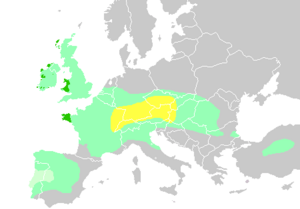
Gaul covered large parts of modern France, Belgium, and Germany. It was home to many Celtic and Belgae tribes. The Romans called these people Gauls. They spoke the Gaulish language. Important cities like Lutetia Parisiorum (Paris) and Burdigala (Bordeaux) were founded by the Celts.
Long before the Romans, Greek sailors settled in what is now Provence. They founded important cities like Massalia (Marseille) and Nikaia (Nice). The Celts often fought with other tribes and with Germans. A Gaulish group led by Brennus even attacked Rome around 393 or 388 BC.
However, the Gauls' tribal society was not as organized as the Roman state. The Romans defeated the Gaulish tribes in battles like Sentinum and Telamon in the 3rd century BC. When Carthaginian commander Hannibal Barca fought the Romans, he hired many Gaulish fighters. This led to the Romans taking over Provence in 122 BC.
Later, Julius Caesar conquered all of Gaul. Despite strong Gaulish resistance led by Vercingetorix, the Gauls were defeated. They had some success at Gergovia, but were finally defeated at Alesia in 52 BC. The Romans then founded cities like Lugdunum (Lyon) and Narbonensis (Narbonne).
Roman Gaul: A New Culture
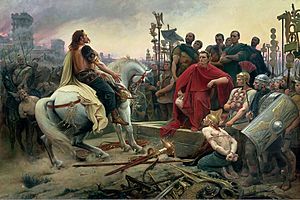
Gaul was divided into several Roman provinces. The Romans moved people around to prevent local groups from becoming a threat. Many Celts were moved or enslaved. Gaul saw a big cultural change under Roman rule. The Gaulish language was slowly replaced by Vulgar Latin. This was easier because Gaulish and Latin had some similarities. Gaul remained under Roman control for centuries, and Celtic culture gradually became Gallo-Roman culture.
Gauls became more integrated into the Roman Empire. Generals like Marcus Antonius Primus and Gnaeus Julius Agricola were born in Gaul, as were emperors Claudius and Caracalla. In 260 AD, Postumus created a short-lived Gallic Empire that included Gaul, Spain, and Britain. Germanic tribes, the Franks and the Alamanni, also entered Gaul around this time. The Gallic Empire ended in 274 AD.
In the 4th century, Celts from Britain, led by Conan Meriadoc, settled in Armorica. They spoke a language that later became Breton. In 418 AD, the Aquitanian province was given to the Goths to help fight the Vandals. These Goths had sacked Rome in 410 AD and set up their capital in Toulouse.
The Roman Empire struggled to deal with all the barbarian raids. Flavius Aëtius used different tribes against each other to keep some Roman control. He used the Huns against the Burgundians, forcing the Burgundians westward. The Burgundians were resettled near Lugdunum in 443 AD. The Huns, led by Attila, became a bigger threat. Aëtius then used the Visigoths against the Huns. The big battle was in 451 AD at Châlons, where Romans and Goths defeated Attila.
The Roman Empire was collapsing. Aquitania was given to the Visigoths, who soon took over much of southern Gaul and Spain. The Burgundians formed their own kingdom. Northern Gaul was left to the Franks. Besides the Germanic peoples, the Vascones entered Wasconia from the Pyrenees, and the Bretons formed three kingdoms in Armorica.
Frankish Kingdoms: From Clovis to Charlemagne
In 486 AD, Clovis I, leader of the Salian Franks, defeated Syagrius at Soissons. He then united most of northern and central Gaul under his rule. Clovis also won battles against other Germanic tribes like the Alamanni. In 496 AD, Clovis became Catholic. This gave him more power and support from his Christian subjects against the Arian Visigoths. He defeated Alaric II at Vouillé in 507 AD and added Aquitaine to his Frankish kingdom.
Clovis made Paris his capital and started the Merovingian dynasty. But his kingdom did not stay united after his death in 511 AD. According to Frankish traditions, all sons inherited part of the land. So, four kingdoms appeared, centered around Paris, Orléans, Soissons, and Rheims. Over time, the borders and number of Frankish kingdoms changed often. During this period, the Mayors of the Palace, who were originally the king's chief advisors, became the real rulers. The Merovingian kings became mostly figureheads.
By this time, Muslims had conquered Spain. Septimania became part of Al-Andalus, which threatened the Frankish kingdoms. Duke Odo the Great defeated a large invading force at Toulouse in 721 AD. However, he failed to stop a raiding party in 732 AD. The mayor of the palace, Charles Martel, defeated that raiding party at the Battle of Tours. This earned him great respect and power. In 751 AD, Pepin the Short (Charles Martel's son) became king, starting the Carolingian dynasty.
Carolingian power reached its peak under Pepin's son, Charlemagne. In 771 AD, Charlemagne reunited the Frankish lands. He then conquered the Lombards in northern Italy (774 AD), added Bavaria (788 AD), defeated the Avars (796 AD), pushed the border with Al-Andalus to Barcelona (801 AD), and took control of Lower Saxony (804 AD).
Because of his successes and support for the papacy, Charlemagne was crowned Emperor of the Romans by Pope Leo III in 800 AD. Charlemagne's son, Louis the Pious (ruled 814–840 AD), kept the empire united. However, this Carolingian Empire did not last after Louis I's death. Two of his sons, Charles the Bald and Louis the German, swore loyalty to each other against their brother, Lothair I, in the Oaths of Strasbourg. The empire was then divided among Louis's three sons in the Treaty of Verdun (843 AD). After a brief reunion (884–887 AD), the imperial title was no longer held in the western part, which became the basis for the future French kingdom.
Under the Carolingians, the kingdom was attacked by Viking raiders. Important figures like Count Odo of Paris and his brother King Robert became famous and even kings. This new family, called the Robertines, were the ancestors of the Capetian dynasty. Some Vikings, led by Rollo, settled in Normandy. King Charles the Simple gave them this land to protect against other raiders. The people who came from the mix of Viking leaders and the Franks and Gallo-Romans became known as the Normans.
Building the Kingdom of France (987–1453)
Powerful Local Rulers
France was very decentralized during the Middle Ages. The king's power was more about religion than administration. In the 11th century, local princes became very powerful. Regions like Normandy, Flanders, or Languedoc had power similar to kingdoms. The Capetians, who came from the Robertians, were powerful princes themselves. They had successfully replaced the weak Carolingian kings.
The Capetians held a dual role: King and Prince. As king, they held the Crown of Charlemagne. As Count of Paris, they held their personal lands, known as Île-de-France.
This dual status made their position complex. They were involved in power struggles within France as princes. But they also had religious authority over Roman Catholicism in France as King. The Capetian kings often treated other princes as enemies or allies, rather than as subjects. Their royal title was recognized but often ignored. In some remote areas, the king's authority was so weak that bandits were the real power.
Some of the king's vassals became very strong rulers in Western Europe. The Normans, Plantagenets, Lusignans, Hautevilles, Ramnulfids, and the House of Toulouse gained lands outside France. The most important conquest for French history was the Norman Conquest by William the Conqueror. After the Battle of Hastings, this linked England to France through Normandy. Even though the Normans were vassals of the French kings, they were also equals as kings of England. Their main political activity stayed in France.
Many French nobles also joined the crusades. French knights founded and ruled the Crusader states. An example of their legacy in the Middle East is the expansion of the Krak des Chevaliers by the Counts of Tripoli and Toulouse.
The Monarchy Grows Stronger
Over the next centuries, the French monarchy gained power over the strong barons. By the 16th century, they had absolute rule over France. Several things helped the French monarchy grow. The Capetian family ruled without interruption until 1328. Laws of primogeniture (eldest son inherits) made sure power passed smoothly. Also, the Capetians were seen as part of an old and famous royal family, making them socially superior to their rivals. Third, the Church supported the Capetians, favoring a strong central government in France. This alliance with the Church was a lasting legacy. The First Crusade was almost entirely made up of French princes. Over time, the King's power grew through conquests, seizures of land, and successful feudal battles.
The history of France as a kingdom truly begins with the election of Hugh Capet (940–996) in Reims in 987. Capet was "Duke of the Franks" and then became "King of the Franks." His lands were small, mostly around Paris. His lack of political importance helped him get elected by powerful barons. Many of his vassals (including the kings of England for a long time) ruled much larger territories than his own. He was recognized as king by many groups, including the Gauls, Bretons, Danes, Aquitanians, Goths, Spanish, and Gascons.
Count Borell of Barcelona asked Hugh for help against Islamic raids. But Hugh was busy fighting Charles of Lorraine. Other Spanish areas then became more independent. Hugh Capet, the first Capetian king, is not well-documented. His greatest achievement was surviving as king and defeating the Carolingian claimant. This allowed him to start what would become one of Europe's most powerful royal families.
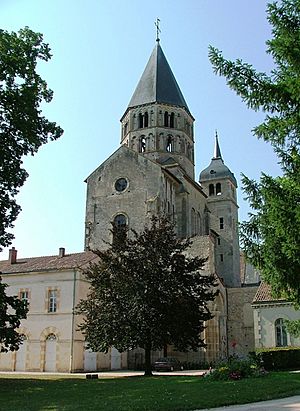
Hugh's son, Robert the Pious, was crowned King of the Franks before his father died. Hugh Capet did this to secure his succession. Robert II met Emperor Henry II in 1023. They agreed to stop claiming each other's lands, setting a new stage for Capetian and Ottonian relations. Though a king with limited power, Robert II made significant efforts. His surviving documents show he relied heavily on the Church, like his father. He was known for his piety, even though he was excommunicated for living with a mistress. Robert II's reign was important for the Peace and Truce of God and the Cluniac Reforms.
Under King Philip I, the kingdom slowly recovered during his long reign (1060–1108). His reign also saw the start of the First Crusade to regain the Holy Land. His family was heavily involved, though he did not personally support it.
From Louis VI (ruled 1108–37) onward, royal authority became more accepted. Louis VI was more a soldier than a scholar. He raised money from his vassals in ways that made him unpopular. His attacks on his vassals, though damaging his image, strengthened royal power. From 1127, Louis had help from a skilled statesman, Abbot Suger. The abbot's advice was very valuable. Louis VI successfully defeated many robber barons. He often called his vassals to court. Those who didn't show up often had their lands taken and faced military campaigns. This policy clearly established royal authority around Paris. By Louis VI's death in 1137, Capetian authority was much stronger.
Thanks to Abbot Suger, King Louis VII (ruled 1137–80) had greater moral authority in France. Powerful vassals paid respect to the French king. Abbot Suger arranged Louis VII's marriage to Eleanor of Aquitaine in 1137. This made Louis VII Duke of Aquitaine and gave him much power. However, the couple disagreed over the burning of over a thousand people in Vitry.
King Louis VII was horrified by this and went to the Holy Land for forgiveness. He later involved France in the Second Crusade, but his relationship with Eleanor did not improve. Their marriage was annulled by the pope. Eleanor soon married Henry Fitzempress, Duke of Normandy, who became King of England two years later. Louis VII, once a powerful monarch, now faced a much stronger vassal. Henry was his equal as King of England and his strongest prince as Duke of Normandy and Aquitaine.
Abbot Suger's building ideas led to what is now known as Gothic architecture. This style became common for most European cathedrals built in the late Middle Ages.
Later Capetian Kings (1165–1328)
The later Capetian kings were much more powerful than the earlier ones. While Philip I could barely control his barons in Paris, Philip IV could influence popes and emperors. This period also saw complex international alliances and conflicts between the kings of France, England, and the Holy Roman Emperor.
Philip II Augustus Expands France
The reign of Philip II Augustus (ruled 1180–1223) was a key time for the French monarchy. His rule greatly expanded the French royal lands and influence. He set the stage for powerful kings like Saint Louis and Philip the Fair.
Philip II spent much of his reign fighting the Angevin Empire, which was a big threat to the King of France. Early in his reign, Philip II used Henry II of England's son against him. He allied with Richard Lionheart, Duke of Aquitaine and Henry II's son. Together, they attacked Henry's castle at Chinon and removed him from power.
Richard became King of England. The two kings then went on the Third Crusade. However, their alliance broke during the crusade. They fought each other in France, and Richard was close to defeating Philip II.
Besides their battles in France, the kings of France and England tried to put their allies in charge of the Holy Roman Empire. Philip II Augustus supported Philip of Swabia. Richard Lionheart supported Otto IV. Otto IV became the Holy Roman Emperor. The French crown was saved when Richard died from a wound he got fighting his own vassals.
John Lackland, Richard's successor, refused to come to the French court for a trial. Philip II then took John's lands in France, just as Louis VI had done to rebellious vassals. John's attempt to win back his French lands at the Battle of Bouvines (1214) failed completely. Philip II added Normandy and Anjou to his lands. He also captured the Counts of Boulogne and Flanders. Aquitaine and Gascony remained loyal to the English king. After the Battle of Bouvines, John's ally, Holy Roman Emperor Otto IV, was overthrown by Frederick II, who was Philip's ally. Philip II of France was very important in shaping politics in England and France.
Philip Augustus founded the Sorbonne and made Paris a city for scholars.
Prince Louis (the future Louis VIII, ruled 1223–26) was involved in the English civil war. This was because French and English nobles, once united, were now split. While French kings fought the Plantagenets, the Church called for the Albigensian Crusade. Southern France was then largely absorbed into the royal lands.
Saint Louis IX (1226–1270)
France truly became a centralized kingdom under Louis IX (ruled 1226–70). Saint Louis is often seen as a perfect example of faith and a good ruler. However, his reign was not perfect for everyone. He led unsuccessful crusades, and his growing government faced opposition. He also ordered the burning of Jewish books. Louis had a strong sense of justice and wanted to judge people himself.
Louis IX was only twelve when he became King of France. His mother, Blanche of Castile, was the real power as regent. Blanche's authority was strongly opposed by French barons, but she kept her position until Louis was old enough to rule.
In 1229, the King had to deal with a long strike at the University of Paris. The kingdom was vulnerable. War continued in the County of Toulouse, and the royal army was busy fighting resistance in Languedoc. Count Raymond VII of Toulouse finally signed the Treaty of Paris in 1229. He kept much of his land for life, but his daughter had no heir. So, the County of Toulouse went to the King of France.
King Henry III of England had not accepted the French king's rule over Aquitaine. He still hoped to get back Normandy and Anjou and rebuild the Angevin Empire. In 1230, he landed in Saint-Malo with a large force. Henry III's allies in Brittany and Normandy did not dare fight their own king, who led the counterattack himself. This led to the Saintonge War (1242).
Henry III was defeated and had to accept Louis IX's rule. Louis IX did not take Aquitaine from Henry III. Louis IX was now the most important landowner in France, in addition to being king. There was some opposition in Normandy, but it was easy to rule compared to Toulouse. The Conseil du Roi, which later became the Parlement, was founded during this time. After his conflict with King Henry III, Louis built a friendly relationship with the English king.
Saint Louis also supported new art forms like Gothic architecture. His Sainte-Chapelle became a famous Gothic building. He is also known for the Morgan Bible. France was involved in two crusades under Saint Louis: the Seventh Crusade and the Eighth Crusade. Both were failures for the French King.
Philip III and Philip IV (1270–1314)
Philip III became king when Saint Louis died in 1270 during the Eighth Crusade. Philip III was called "the Bold" because of his fighting skills, not his personality. Philip III took part in another failed crusade, the Aragonese Crusade, which cost him his life in 1285.
More government changes were made by Philip IV, also called Philip the Fair (ruled 1285–1314). This king was responsible for ending the Knights Templar. He signed the Auld Alliance and established the Parlement of Paris. Philip IV was so powerful that he could name popes and emperors. The papacy was moved to Avignon, and all popes at that time were French, like Philip IV's puppet Bertrand de Goth.
Early Valois Kings and the Hundred Years' War (1328–1453)
Tensions between the Plantagenet and Capet families exploded during the Hundred Years' War (1337 to 1453). The Plantagenets claimed the French throne from the Valois. This was also the time of the Black Death and several civil wars. The French people suffered greatly. In 1420, the Treaty of Troyes made Henry V heir to Charles VI. Henry V died before Charles, so Henry VI of England became king of both England and France.
Some say the hard times during the Hundred Years' War sparked French nationalism, led by Joan of Arc (1412–1431). The Hundred Years' War is remembered more as a war between France and England than as feudal struggles. During this war, France changed politically and militarily.
A French-Scottish army won at the Battle of Baugé (1421). But the defeats at Poitiers (1356) and Agincourt (1415) made French nobles realize they needed an organized army, not just knights. Charles VII (ruled 1422–61) created the first French standing army. He defeated the Plantagenets at Patay (1429) and again, using cannons, at Formigny (1450). The Battle of Castillon (1453) was the last battle of this war. Only Calais and the Channel Islands remained under English rule.
Early Modern France (1453–1789)
Life in Early Modern France
France in the Ancien Régime was about 520,000 square kilometers. It had 13 million people in 1484 and 20 million in 1700. France had the second-largest population in Europe around 1700. This lead slowly faded after 1700 as other countries grew faster.
In 1500, people didn't really feel "French"; they felt more connected to their local areas. By 1600, however, people started calling themselves "good Frenchmen."
Power and Society
Political power was spread out. The law courts (Parlements) were powerful, especially in Paris. But the king had only about 10,000 officials for such a large country with slow communication. Travel was faster by sea or river. The different estates of the realm—the clergy, the nobility, and commoners—sometimes met in the "Estates General." But this group had no real power; it could only ask the king for things, not make laws.
The Catholic Church controlled about 40% of the wealth. The king, not the pope, chose bishops. However, he usually had to negotiate with noble families linked to local churches.
The nobility was second in wealth, but they were not united. Each noble had their own lands, local connections, and military force.
Cities had a semi-independent status, controlled by leading merchants and guilds. Paris was the largest city, with 220,000 people in 1547. Lyon and Rouen each had about 40,000 people. Lyon had strong banking and culture.
Peasants made up most of the population. In 1484, about 97% of France's 13 million people lived in rural villages. In 1700, at least 80% of the 20 million people were peasants.
In the 17th century, peasants were connected to the market economy. They invested in farming and often moved between villages or towns. Moving for work was the main way to improve one's social standing.
Language and Culture
Most peasants spoke local dialects. But an official language grew in Paris, and French became the language of Europe's nobles and diplomacy. Holy Roman Emperor Charles V joked, "I speak Spanish to God, Italian to women, French to men, and German to my horse."
Because of its international status, there was a desire to standardize French. Several reforms made it more uniform. The Renaissance writer François Rabelais helped shape French as a literary language, bringing back Greek and Latin words. Jacques Peletier du Mans also reformed French, improving the number system.
France Grows Stronger (15th and 16th Centuries)

After the death of Charles the Bold in 1477, France and the Habsburgs began a long process of dividing his rich Burgundian lands, leading to many wars. In 1532, Brittany became part of the Kingdom of France.
France fought in the long Italian Wars (1494–1559), which marked the start of early modern France. Francis I faced powerful enemies and was captured at Pavia. The French king then sought allies and found one in the Ottoman Empire. The Ottoman Admiral Barbarossa captured Nice in 1543 and gave it to Francis I.
In the 16th century, the Spanish and Austrian Habsburgs were the strongest power in Europe. The many lands of Charles V surrounded France. The Spanish Tercio (a type of military unit) was very successful against French knights. Finally, in 1558, the Duke of Guise took Calais from the English.
The "Beautiful 16th Century"
Historians call the period from about 1475 to 1630 the "beautiful 16th century." This was a time of peace, prosperity, and hope across the nation, with steady population growth. Paris, for example, grew to 200,000 people by 1550. In Toulouse, the Renaissance brought wealth that changed the city's architecture. In 1559, Henry II of France signed peace treaties with Elizabeth I of England and Philip II of Spain. This ended long conflicts between France, England, and Spain.
Religious Wars: Protestants and Catholics (1562–1629)
The Protestant Reformation, mainly inspired by John Calvin in France, began to challenge the Catholic Church. Calvin, from Geneva, Switzerland, was dedicated to reforming his homeland. He provided the ideas, worship style, and social rules for the new religion. He also created church and political structures.
Between 1555 and 1562, over 100 ministers were sent to France. However, French King Henry II severely punished Protestants under the Edict of Chateaubriand (1551). The two main Calvinist (Huguenot) strongholds were southwest France and Normandy, but Catholics were still the majority there. A renewed Catholic reaction, led by the powerful Francis, Duke of Guise, led to a massacre of Huguenots at Vassy in 1562. This started the first of the French Wars of Religion. English, German, and Spanish forces got involved, supporting either Protestants or Catholics.
King Henry II died in 1559. He was followed by his three sons, who were either too young or weak rulers. Henry's widow, Catherine de' Medici, became a key figure in the early Wars of Religion. She is often blamed for the St. Bartholomew's Day massacre of 1572, when thousands of Huguenots were killed in Paris and other parts of France.
The Wars of Religion ended with the War of the Three Henrys (1584–98). During this war, King Henry III's bodyguards killed Henry de Guise, leader of the Spanish-backed Catholic league. In revenge, a priest killed Henry III in 1589. This led to the Huguenot Henry IV becoming king. To bring peace, he converted to Catholicism, famously saying, "Paris is worth a Mass." He issued the Edict of Nantes in 1598, which gave Protestants religious freedom and ended the civil war. Huguenots could hold services in certain towns, control and fortify eight cities, and had equal civil rights with Catholics.
Henry IV was killed in 1610 by a fanatical Catholic.
In 1620, the Huguenots declared a constitution for the 'Republic of the Reformed Churches of France'. The chief minister, Cardinal Richelieu (1585–1642), used the full power of the state to stop this. Religious conflicts continued under Louis XIII. Richelieu forced Protestants to give up their army and fortresses. This conflict ended with the Siege of La Rochelle (1627–28), where Protestants and their English supporters were defeated. The following Peace of Alais (1629) confirmed religious freedom but removed Protestant military defenses.
Many Huguenots fled France due to persecution, going to Protestant countries in Europe and America.
Thirty Years' War (1618–1648)
The religious conflicts in France also affected the Habsburg-led Holy Roman Empire. The Thirty Years' War weakened the Catholic Habsburgs. Even though Cardinal Richelieu had fought Protestants in France, he joined the war on their side in 1636 because it was in France's national interest. Habsburg forces invaded France, attacked Champagne, and almost reached Paris.
Richelieu died in 1642 and was replaced by Cardinal Mazarin. Louis XIII died a year later and was replaced by Louis XIV. France had skilled commanders like Louis II de Bourbon, Prince de Condé and Henri de la Tour d'Auvergne, Vicomte de Turenne. French forces won a key victory at Rocroi (1643), destroying the Spanish army. The Truce of Ulm (1647) and the Peace of Westphalia (1648) ended the war.
Some challenges remained. France faced civil unrest called The Fronde. This turned into the Franco-Spanish War in 1653. Louis II de Bourbon joined the Spanish army but was defeated at Dunkirk (1658). The Treaty of the Pyrenees (1659) forced harsh terms on Spain, and France gained Northern Catalonia.
During this time, René Descartes used logic and reason to answer philosophical questions, creating what is called Cartesian Dualism in 1641.
French Colonies (16th and 17th Centuries)
In the 16th century, the king began claiming North American lands and established several colonies. Jacques Cartier was a great explorer who traveled deep into American territories.
The early 17th century saw the first successful French settlements in the New World with the voyages of Samuel de Champlain. The largest settlement was New France, with towns like Quebec City (1608) and Montreal (founded in 1642).
Louis XIV: The Sun King (1643–1715)
Louis XIV, known as the "Sun King," ruled France from 1643 to 1715. His strong personal rule began in 1661 after his chief minister, Cardinal Mazarin, died. Louis believed in the divine right of kings, meaning a king is above everyone but God. He continued to create a centralized state ruled from Paris, trying to remove old feudal ways and weaken the nobles. He built a system of absolute rule that lasted until the French Revolution. However, Louis XIV's long reign involved many wars that cost a lot of money.
His reign started during the Thirty Years' War and the Franco-Spanish war. His military architect, Vauban, became famous for his pentagonal fortresses. Jean-Baptiste Colbert managed the royal spending. French forces fought the Ottoman Turks at the Battle of Saint Gotthard in 1664, winning with the help of 6,000 French troops.
France fought the War of Devolution against Spain in 1667. France's victory worried England and Sweden. With the Dutch Republic, they formed the Triple Alliance to stop Louis XIV's expansion. Louis II de Bourbon had captured Franche-Comté, but Louis XIV agreed to the peace of Aachen. He did not annex Franche-Comté but gained Lille.
Peace was short-lived. War broke out again between France and the Dutch Republic in the Franco-Dutch War (1672–78). France attacked the Dutch Republic, joined by England. The Dutch stopped the French invasion by flooding their lands. The Dutch Admiral Michiel de Ruyter defeated the Anglo-French navy, forcing England to leave the war in 1674. The Netherlands eventually agreed to peace in the Treaties of Nijmegen, where France gained Franche-Comté and more land in the Spanish Netherlands.
In 1682, the royal court moved to the grand Palace of Versailles, which Louis XIV had greatly expanded. Louis XIV made many nobles live at Versailles. He controlled them with pensions and privileges, replacing their power with his own.
War between France and Spain started again. The War of the Reunions (1683–84) saw Spain and the Holy Roman Empire defeated again. In October 1685, Louis signed the Edict of Fontainebleau, ordering the destruction of all Protestant churches and schools in France. This led to many Protestants leaving France. Over two million people died in famines in 1693 and 1710.
France was soon in another war, the War of the Grand Alliance. This war was fought in Europe and North America. It was long and difficult (also called the Nine Years' War), but the results were unclear. The Treaty of Ryswick in 1697 confirmed French rule over Alsace but rejected its claims to Luxembourg. Louis also had to leave Catalonia and the Palatinate. This peace was seen as a temporary break, and war was expected to start again.
In 1701, the War of the Spanish Succession began. The Bourbon Philip of Anjou was named heir to the Spanish throne. The Habsburg Emperor Leopold opposed this, fearing it would give too much power to the French Bourbons and upset the balance of power in Europe. England and the Dutch Republic joined Leopold against Louis XIV and Philip of Anjou. The allied forces, led by John Churchill, 1st Duke of Marlborough and Prince Eugene of Savoy, defeated the French army several times. The Battle of Blenheim in 1704 was France's first major land defeat since Rocroi in 1643. However, the very bloody battles of Ramillies (1706) and Malplaquet (1709) were Pyrrhic victories for the allies, meaning they lost too many men to continue. Led by Villars, French forces regained much lost ground in battles like Denain (1712). Finally, a compromise was reached with the Treaty of Utrecht in 1713. Philip of Anjou was confirmed as Philip V, king of Spain, but he was forbidden from inheriting the French throne.
Louis XIV wanted to be remembered as a supporter of the arts, like Louis IX. He invited Jean-Baptiste Lully to create the French opera. Jules Hardouin Mansart became France's most important architect, bringing the best of French Baroque architecture.
The wars were very expensive and did not lead to clear victories. France gained some land to the east, but its enemies grew stronger. Vauban, France's top military strategist, warned the King in 1689 that a hostile "Alliance" was too strong at sea. He suggested that France should allow its merchant ships to attack enemy merchant ships, avoiding their navies.
Changes in France and the World (1718–1783)

Louis XIV died in 1715. His five-year-old great-grandson, Louis XV, became king and ruled until 1774. In 1718, France was at war again, as Philip II of Orléans's regency joined the War of the Quadruple Alliance against Spain. King Philip V of Spain had to withdraw, realizing Spain was no longer a great power. Under Cardinal Fleury's rule, peace was kept as long as possible.
However, in 1733, another war started in central Europe over the Polish succession. France joined against the Austrian Empire. This time, there was no invasion of the Netherlands, and Britain stayed neutral. Austria was left alone against a French-Spanish alliance and suffered a military disaster. Peace was made in the Treaty of Vienna (1738), where France gained the Duchy of Lorraine through inheritance.
Two years later, in 1740, war broke out over the Austrian succession, and France joined. The war was fought in North America and India, as well as Europe. The Treaty of Aix-la-Chapelle (1748) ended it with unclear terms. Everyone saw this as a temporary truce. Prussia was becoming a new threat, gaining much land from Austria. This led to the Diplomatic Revolution of 1756, where alliances changed. France was now allied with Austria and Russia, while Britain was allied with Prussia.
In North America, France allied with Native American peoples during the Seven Years' War. Despite early successes, French forces were defeated at the Battle of the Plains of Abraham in Quebec. In Europe, French attempts to take Hanover failed. In 1762, Russia, France, and Austria were close to defeating Prussia. But the Anglo-Prussian Alliance was saved by the "Miracle of the House of Brandenburg." At sea, naval defeats against British fleets in 1759 forced France to keep its ships in port. Finally, peace was made in the Treaty of Paris (1763), and France lost its North American empire.
Britain's success in the Seven Years' War made it the leading colonial power, surpassing France. France sought revenge and, under Choiseul, began to rebuild. In 1766, France annexed Lorraine. The next year, it bought Corsica from Genoa.
Having lost its colonies, France saw a chance for revenge against Britain. It allied with the Americans in 1778, sending an army and navy that turned the American Revolution into a world war. Spain and the Dutch Republic also joined France. Admiral de Grasse defeated a British fleet at Chesapeake Bay. Jean-Baptiste Donatien de Vimeur, comte de Rochambeau and Gilbert du Motier, Marquis de Lafayette joined American forces to defeat the British at Yorktown. The war ended with the Treaty of Paris (1783), making the United States independent. The British Royal Navy won a major victory over France in 1782 at the Battle of the Saintes. France ended the war with huge debts and only gained the island of Tobago.
The French Enlightenment
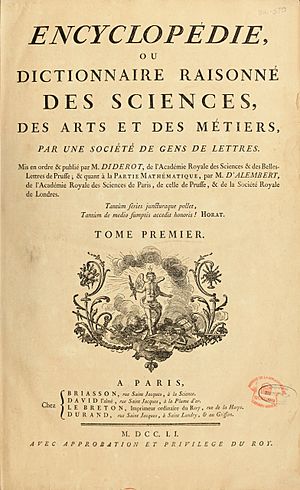
The "Philosophes" were French thinkers in the 18th century who led the French Enlightenment. They were influential across Europe. They studied science, literature, philosophy, and society. Their main goal was human progress. They believed that a rational society would come from free and reasoned thinking. They also supported Deism and religious tolerance. Many thought religion had caused conflict for too long, and that logical thought was the way forward.
The philosopher Denis Diderot was the chief editor of the famous Enlightenment work, the 72,000-article Encyclopédie (1751–72). It greatly influenced learning worldwide.
Early in the 18th century, Voltaire and Montesquieu led the movement. It grew stronger as the century went on. Opposition was weakened by disagreements within the Catholic Church, the weakening of the absolute monarchy, and many expensive wars. So, the Philosophes' influence spread. Around 1750, they were most influential. Montesquieu published Spirit of Laws (1748), and Jean Jacques Rousseau published Discourse on the Moral Effects of the Arts and Sciences (1750).
The leader of the French Enlightenment and a very influential writer was Voltaire (1694–1778). His many books included poems, plays, satires (like Candide), history, science, and philosophy. He also wrote many articles for the Encyclopédie. He was a witty opponent of the alliance between the French state and the church, and was exiled from France several times. In England, he learned about British thought and helped make Isaac Newton famous in Europe.
Astronomy, chemistry, mathematics, and technology thrived. French chemists like Antoine Lavoisier worked to replace old units of measurement with a scientific system. Lavoisier also discovered oxygen and hydrogen.
Revolutionary France (1789–1799)
Why the French Revolution Started

When King Louis XV died in 1774, he left his grandson, Louis XVI, with "ruined finances, unhappy subjects, and a faulty government." Still, people had faith in the king, and Louis XVI's arrival was welcomed.
A decade later, recent wars, especially the Seven Years' War (1756–63) and the American Revolutionary War (1775–83), had left the country bankrupt. The tax system was very inefficient. Several years of bad harvests and poor transportation caused food prices to rise, leading to hunger. The country became more unstable as the lower classes felt the royal court didn't care about their hardships.
In February 1787, the king's finance minister, Charles Alexandre de Calonne, called an Assembly of Notables. This group of nobles, clergy, and wealthy citizens was chosen to bypass local parliaments. They were asked to approve a new land tax that would include nobles and clergy for the first time. The assembly did not approve the tax. Instead, they demanded that Louis XVI call the Estates-General.

The National Assembly and the Bastille (January – July 1789)
In August 1788, the King agreed to call the Estates-General in May 1789. The Third Estate (commoners) demanded and got "double representation" to balance the First (clergy) and Second (nobles) Estates. However, voting was "by orders," meaning each estate had one vote, which canceled the double representation. This led the Third Estate to break away and, joined by some from other estates, declare the National Assembly. This was an assembly of "the People," not just estates.
To keep control, Louis XVI ordered the Salle des États, where the Assembly met, to be locked. The Assembly then met on a tennis court and took the Tennis Court Oath on 20 June 1789. They promised not to separate until a constitution was made. Some sympathetic nobles and clergy joined them. After the king fired his finance minister, Jacques Necker, fears grew that royalists might threaten the new Assembly.
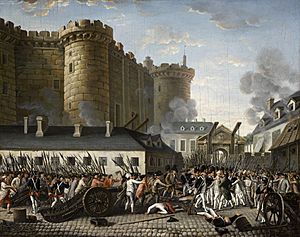
Paris soon saw riots and looting. The royal leadership left the city, and mobs gained support from the French Guard, including weapons. On 14 July 1789, the rebels targeted the Bastille fortress, a symbol of royal tyranny. Insurgents seized the Bastille prison. France now celebrates 14 July as 'Bastille day' or Quatorze Juillet, symbolizing the move from the Ancien Régime to a modern, democratic state.
Changes to the Church (October 1789 – December 1790)
In October 1789, a mob from Paris attacked the royal palace at Versailles. They were seeking help for their poverty. The royal family was forced to move to the Tuileries Palace in Paris.
Under the Ancien Régime, the Roman Catholic Church owned the most land in France. In November 1789, the Assembly decided to take over and sell all church property. This helped with the financial crisis.
In July 1790, the Assembly passed the Civil Constitution of the Clergy. This law reorganized the French Catholic Church. Priests' salaries would now be paid by the state. The Church's right to tax crops was removed, and some clergy privileges were canceled. In October, 30 bishops said they could not accept the law. This increased public opposition. In late November 1790, the Assembly ordered all clergy to swear loyalty to the Civil Constitution. This made resistance stronger, especially in western France (Normandy, Brittany, and the Vendée). Few priests took the oath, and people turned against the revolution. Priests who swore the oath were called 'constitutional'; those who didn't were 'non-juring' or 'refractory'.
Creating a Constitutional Monarchy (June–September 1791)
In June 1791, the royal family secretly fled Paris in disguise to Varennes, near France's northeastern border. They hoped to find royalist support. But they were discovered and brought back to Paris. They were then kept under house arrest at the Tuileries.
In August 1791, Emperor Leopold II of Austria and King Frederick William II of Prussia issued the Declaration of Pillnitz. They said they wanted to help the French king "consolidate a monarchical government." They were preparing their troops. This angered the French, who militarized their borders.
Most of the Assembly still wanted a constitutional monarchy. They reached a compromise. Under the Constitution of 3 September 1791, France would be a constitutional monarchy. Louis XVI would be mostly a figurehead. The King had to share power with the elected Legislative Assembly. He still had his royal veto and could choose ministers. He had to swear an oath to the constitution. A decree said that breaking the oath or leading an army against the nation would mean he was no longer king.
War and Uprisings (October 1791 – August 1792)
On 1 October 1791, the Legislative Assembly was formed. Its members were elected by 4 million men (out of 25 million) who paid a certain amount of taxes. A group of Assembly members who wanted war against Austria and Prussia were called 'Girondins'. A group around Maximilien Robespierre, later called 'Montagnards' or 'Jacobins', argued against war. This disagreement grew stronger.
In response to the threat from Austria and Prussia in August 1791, Assembly leaders saw war as a way to strengthen their government. On 20 April 1792, France declared war on Austria. In late April 1792, France invaded and conquered the Austrian Netherlands (today's Belgium and Luxembourg).
In summer 1792, Paris turned against the king. People hoped the Assembly would remove him, but the Assembly hesitated. On 10 August 1792, a large crowd of Parisians and soldiers marched on the Tuileries Palace. The king decided to leave and seek safety with his family in the Assembly. The Assembly 'temporarily relieved the king from his task'. On 19 August, a Prussian army invaded France and attacked Longwy. In late August 1792, elections were held for the new National Convention, with all men allowed to vote. On 26 August, the Assembly ordered the deportation of 'refractory priests' from western France, calling them "dangers to the fatherland." In response, peasants in the Vendée took over a town, moving closer to civil war.
Bloodshed and the Republic (September 1792)
On 2, 3, and 4 September 1792, about 300 volunteers and supporters of the revolution, angered by Verdun being captured by the Prussians, raided Parisian prisons. Rumors spread that foreign enemies were conspiring with prisoners. The Assembly and the Paris city council seemed unable to stop the bloodshed.
On 20 September 1792, the French won a battle against Prussian troops near Valmy. The new National Convention replaced the Legislative Assembly. From the start, the Convention was divided between the 'Montagnards' (or 'Jacobins') led by Robespierre, Danton, and Marat, and the 'Girondins'. Most representatives, called 'la Plaine', were neutral and kept debates moving. On 21 September, the Convention abolished the monarchy, making France the French First Republic. A new French Republican Calendar was introduced, renaming 1792 as year 1 of the Republic.
War and Civil War (November 1792 – Spring 1793)
Wars against Prussia and Austria had started in 1792. In November, France also declared war on Kingdom of Great Britain and the Dutch Republic. Former king Louis XVI was tried, convicted, and guillotined in January 1793.
In February 1793, a nationwide conscription (draft) for the army was introduced. This sparked a civil war in the Vendée in March. This region had been rebellious since 1790 due to the Civil Constitution of the Clergy. Meanwhile, France also declared war on Spain in March. That month, Vendée rebels won some victories. The French army was defeated in Belgium by Austria, and French general Dumouriez defected to the Austrians. The French Republic's survival was in danger.
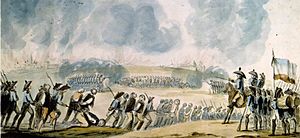
On 6 April 1793, the Committee of Public Safety was created. This group of nine (later twelve) members acted as the executive government, accountable to the Convention. That month, the 'Girondins' accused Jean-Paul Marat of trying to destroy the people's power and encouraging violence. Marat was quickly found innocent, but this made the conflict between 'Girondins' and 'Montagnards' worse. In spring 1793, Austrian, British, Dutch, and Spanish troops invaded France.
Political Showdown (May–June 1793)
The rivalry between 'Montagnards' and 'Girondins' in the National Convention had been growing since late 1791. On 24 May 1793, Jacques Hébert, a Montagnard supporter, called on the sans-culottes (working-class Parisians) to revolt against the "henchmen of Capet and Dumouriez." Hébert was immediately arrested. The anger of the sans-culottes was aimed at the Girondins. On 25 May, a delegation from the Paris city council protested Hébert's arrest. The Convention's President, a Girondin, warned them: "If something happens to the nation's representatives, I declare that Paris will be totally destroyed."
On 29 May 1793, an uprising in Lyon overthrew the Montagnard rulers. Marseille, Toulon, and other cities saw similar events.
On 2 June 1793, the Convention's session in the Tuileries Palace became chaotic. Crowds, including 80,000 armed soldiers, surrounded the palace. Constant shouting from the public galleries, always favoring the Montagnards, made it seem like all of Paris was against the Girondins. Petitions were passed, accusing 22 Girondins. Barère, from the Committee of Public Safety, suggested that the Girondin leaders should resign to end the division. A decree was passed, expelling 22 leading Girondins from the Convention. That night, dozens of Girondins resigned and left.
In 1793, the Holy Roman Empire, the kings of Portugal and Naples, and the Grand-Duke of Tuscany declared war against France.
Counter-Revolution Suppressed (July 1793 – April 1794)
By summer 1793, most French departments opposed the central Paris government. Often, 'Girondins' who had fled Paris after June led these revolts. In Brittany, people who rejected the Civil Constitution of the Clergy of 1790 started a guerrilla war called Chouannerie. But generally, the opposition against Paris became a struggle for power against the 'Montagnards' (Robespierre and Marat) who now controlled Paris.
In June–July 1793, Bordeaux, Marseilles, Brittany, Caen, and the rest of Normandy gathered armies to march on Paris. In July, Lyon guillotined the Montagnard head of its city council. Barère, from the Committee of Public Safety, urged tougher measures against the Vendée on 1 August: "We'll have peace only when no Vendée remains... we'll have to exterminate that rebellious people." In August, Convention troops besieged Lyon.
In August–September 1793, activists urged the Convention to do more to stop the counter-revolution. A delegation from the Paris city council suggested forming revolutionary armies to arrest hoarders and conspirators. Bertrand Barère, from the Committee of Public Safety, agreed on 5 September, saying: let's "make terror the order of the day!" On 17 September, the National Convention passed the Law of Suspects. This law ordered the arrest of all opponents of the government and suspected "enemies of freedom." This led to 17,000 death sentences by July 1794, a period historians call 'the (Reign of) Terror'.
On 19 September, the Vendée rebels again defeated a Republican army. On 1 October, Barère repeated his call to subdue the Vendée, calling it a "refuge of fanaticism." In October, Convention troops captured Lyon and restored a Montagnard government.
Rules for bringing someone before the Revolutionary Tribunal (created March 1793) were always broad. By August, political disagreement was enough to be summoned. There was no appeal against a Tribunal verdict. In late August 1793, an army general was guillotined for choosing timid strategies. In mid-October, former queen Marie Antoinette was tried and guillotined. In October, 21 former 'Girondins' Convention members were executed for supporting an uprising in Caen.
On 17 October 1793, the Republican army defeated the Vendéan army near Cholet. All surviving Vendée residents, tens of thousands, fled north into Brittany. A Convention representative was sent to Nantes to calm the region. By November 1793, revolts in Normandy, Bordeaux, and Lyon were crushed. Toulon was also defeated in December. Two representatives sent to punish Lyon executed 2,000 people. The Vendéan army in Brittany was defeated on 12 December 1793, with 10,000 rebels dying. Some historians say that after this defeat, Republican armies massacred 117,000 Vendéan civilians in 1794. Others disagree. Some historians believe the civil war lasted until 1796, with 450,000 deaths.
Executing Politicians (February–July 1794)
Maximilien Robespierre, a member of the Committee of Public Safety since July 1793, said in a speech on 5 February 1794 that Jacques Hébert and his group were "internal enemies." After a questionable trial, Hébert and some allies were guillotined in March. On 5 April, again at Robespierre's urging, Danton and 13 other politicians were executed. A week later, 19 more politicians were killed. This silenced the Convention members; they hardly dared to speak against Robespierre. A law passed on 10 June 1794 made trials even faster: if the Revolutionary Tribunal found enough proof of someone being an "enemy of the people," a defense lawyer was not allowed. The number of guillotine executions in Paris rose from about three a day to 29 a day.
Meanwhile, France's wars abroad were going well. Victories over Austrian and British troops in May and June 1794 opened Belgium for French conquest. However, cooperation within the Committee of Public Safety began to break down. On 29 June 1794, three of Robespierre's colleagues called him a dictator. Robespierre, shocked, left the meeting. This encouraged other Convention members to defy him. On 26 July, Robespierre's long speech was met with hostility instead of applause.
In the Convention session of 27 July 1794, Robespierre and his allies could barely speak due to constant interruptions. Finally, Robespierre's voice failed him. A decree was passed to arrest Robespierre, Saint-Just, and Couthon. On 28 July, they and 19 others were executed. On 29 July, 70 more Parisians were guillotined. The Law of 22 Prairial was then canceled. The 'Girondins' who had been expelled in June 1793 were brought back as Convention deputies if they were still alive.
Ignoring the Working Classes (August 1794 – October 1795)
After July 1794, most people ignored the Republican calendar and went back to the traditional seven-day weeks. A law on 21 February 1795 allowed freedom of religion and reconciliation with the refractory Catholic priests. But religious symbols outside churches or private homes, like crosses or bell ringing, were still forbidden. When church attendance grew, the government changed its mind. In October 1795, it again required all priests to swear oaths to the Republic.
In the very cold winter of 1794–95, with the French army needing more bread, food became scarce in Paris. Wood for heating was also rare. On 1 April 1795, a mostly female crowd marched on the Convention, demanding bread. But no Convention member sympathized; they told the women to go home. In May, a crowd of 20,000 men and 40,000 women invaded the Convention again. Still, they failed to make the Convention address the needs of the lower classes. Instead, the Convention banned women from all political meetings. Deputies who supported the uprising were sentenced to death.
In late 1794, France conquered present-day Belgium. In January 1795, they took over the Dutch Republic with the help of the Dutch 'patriots' movement, creating the Batavian Republic, a French satellite state. In April 1795, France made a peace agreement with Prussia. Later that year, peace was agreed with Spain.
Fighting Catholicism and Royalism (October 1795 – November 1799)
In October 1795, the Republic was reorganized. The one-chamber parliament (the National Convention) was replaced by a two-chamber system. The 'Council of 500' started laws, and the 'Council of Elders' reviewed them. Each year, one-third of the chambers were renewed. The executive power was held by five directors—giving the government its name, 'Directory'—with five-year terms. Each year, one director was replaced. The early directors did not understand the nation well. They saw Catholicism as counter-revolutionary and royalist. Local officials had a better sense of people's needs. One wrote to the interior minister: "Give back the crosses, the church bells, the Sundays, and everyone will cry: 'Long live the Republic!'"
French armies in 1796 advanced into Germany, Austria, and Italy. In 1797, France conquered the Rhineland, Belgium, and much of Italy.
Parliamentary elections in spring 1797 showed big gains for royalists. This scared the republican directors. They staged a coup d'état on 4 September 1797 (Coup of 18 Fructidor V) to remove two supposedly pro-royalist directors and some royalists from both Councils. The new government, still believing Catholicism and royalism were dangerous, started a new campaign to promote the Republican calendar (introduced in 1792) with its ten-day week. They tried to make the tenth day, décadi, a substitute for the Christian Sunday. Citizens opposed and mocked these decrees, and local officials refused to enforce them.
France was still fighting wars. In 1798, in Egypt, Switzerland, Rome, Ireland, Belgium, and against the U.S.A.. In 1799, in Baden-Württemberg. In 1799, when French armies abroad faced setbacks, the newly chosen director Sieyes thought the Directory needed a stronger executive. With general Napoleon Bonaparte, who had just returned, Sieyes prepared another coup d'état. It happened on 9–10 November 1799, replacing the five directors with three "consuls:" Napoleon, Sieyes, and Roger Ducos.
Napoleonic France (1799–1815)
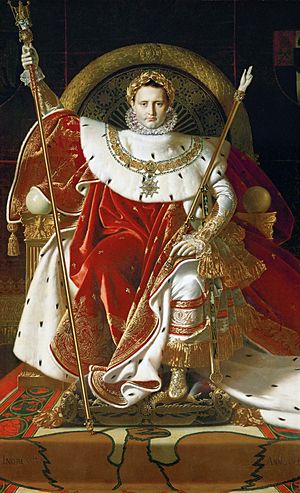
During the War of the First Coalition (1792–1797), the Directory ruled France. Great Britain was still at war with France. A plan was made to take Egypt from the Ottoman Empire, a British ally. This was Napoleon's idea, and the Directory agreed to send the popular general away from France. Napoleon defeated the Ottoman forces at the Battle of the Pyramids (21 July 1798). He also sent scientists to explore Egypt. But a few weeks later, the British fleet under Admiral Horatio Nelson destroyed the French fleet at the Battle of the Nile (1–3 August 1798). Napoleon planned to move into Syria but was defeated at the Siege of Acre. He returned to France without his army.
The Directory was threatened by the Second Coalition (1798–1802). Royalists still wanted to restore the monarchy. Prussia and Austria did not accept their land losses from the previous war. In 1799, the Russian army drove the French from Italy. The Austrian army defeated the French in Switzerland. Napoleon then took power in a coup and created the Consulate in 1799. The Austrian army was defeated at the Battle of Marengo (1800) and again at the Battle of Hohenlinden (1800).
At sea, the French had some success at Boulogne. But Nelson's Royal Navy destroyed a Danish and Norwegian fleet at the Battle of Copenhagen (1801). The Second Coalition was defeated. Peace was made in the Treaty of Lunéville and the Treaty of Amiens. A short period of peace followed in 1802–03. During this time, Napoleon sold French Louisiana to the United States because it was hard to defend.
In 1801, Napoleon made a "Concordat" with Pope Pius VII. This started peaceful relations between church and state in France. Revolutionary policies were reversed, but the Church did not get its lands back. Bishops and clergy received state salaries, and the government paid for church buildings. Napoleon reorganized higher education.
In 1804, the senate named Napoleon Emperor, starting the First French Empire. Napoleon's rule was constitutional and, though autocratic, more modern than traditional European monarchies. The French Empire's creation led to the War of the Third Coalition. The French army was renamed La Grande Armée in 1805. Napoleon used propaganda and nationalism to control the French people. The French army won a big victory at Ulm (16–19 October 1805), capturing an entire Austrian army.
A French-Spanish fleet was defeated at Trafalgar (21 October 1805). This made plans to invade Britain impossible. Despite this naval defeat, the war was won on land. Napoleon inflicted one of their greatest defeats on the Austrian and Russian Empires at Austerlitz (2 December 1805), destroying the Third Coalition. Peace was made in the Treaty of Pressburg. The Austrian Empire lost the title of Holy Roman Emperor. Napoleon created the Confederation of the Rhine from former Austrian lands.
Alliances Against Napoleon
Prussia joined Britain and Russia, forming the Fourth Coalition. The French Empire also had many allies and subject states. The French army, though outnumbered, crushed the Prussian army at Jena-Auerstedt in 1806. Napoleon captured Berlin and went to Eastern Prussia. There, the Russian Empire was defeated at the Battle of Friedland (14 June 1807). Peace was made in the Treaties of Tilsit. Russia had to join the Continental System, and Prussia gave half its lands to France. The Duchy of Warsaw was formed from these lands, and many Polish troops joined the Grande Armée.
To harm the British economy, Napoleon set up the Continental System in 1807. He tried to stop European merchants from trading with Britain. A lot of smuggling frustrated Napoleon, and it hurt his economy more than his enemies'.
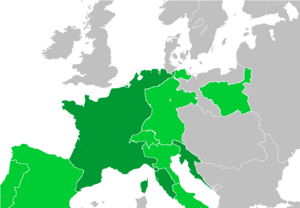
Free from the east, Napoleon turned west. The French Empire was still at war with Britain. Only Sweden and Portugal remained neutral. Napoleon then looked at Portugal. In the Treaty of Fontainebleau (1807), France and Spain allied against Portugal. French armies entered Spain to attack Portugal, but then took Spanish fortresses and the kingdom by surprise. Joseph Bonaparte, Napoleon's brother, became King of Spain after Charles IV gave up the throne.
This occupation of Spain and Portugal sparked local nationalism. Soon, the Spanish and Portuguese fought the French using guerilla tactics. They defeated French forces at the Battle of Bailén (June and July 1808). Britain sent ground support to Portugal, and French forces left Portugal after the Allied victory at Vimeiro (21 August 1808). France only controlled Catalonia and Navarre.
Another French attack was launched on Spain, led by Napoleon himself. However, the French Empire was no longer seen as unbeatable. In 1808, Austria formed the Fifth Coalition to break the French Empire. The Austrian Empire defeated the French at Aspern-Essling, but was beaten at Wagram. Polish allies defeated the Austrian Empire at Raszyn (April 1809). Though not as decisive as earlier defeats, the peace treaty in October 1809 took much land from Austria, weakening it further.
In 1812, war broke out with Russia, leading to Napoleon's disastrous French invasion of Russia (1812). Napoleon gathered the largest army Europe had ever seen to invade Russia. After a long march and the bloody Battle of Borodino, the Grande Armée entered Moscow. But they found it burning, part of Russia's scorched earth tactics. The Napoleonic army left Russia in late 1812, mostly destroyed by the Russian winter, exhaustion, and scorched earth. On the Spanish front, French troops were defeated at Vitoria (June 1813) and then at the Battle of the Pyrenees (July–August 1813). The Spanish guerrillas were uncontrollable, so French troops eventually left Spain.
Since France was defeated on two fronts, states conquered by Napoleon saw a chance to fight back. The Sixth Coalition formed under British leadership. German states joined against Napoleon. Napoleon was largely defeated at the Battle of the Nations in October 1813. His forces were outnumbered and overwhelmed during the Six Days Campaign (February 1814). Napoleon gave up his throne on 6 April 1814 and was exiled to Elba.
The conservative Congress of Vienna reversed the political changes from the wars. Napoleon suddenly returned, took control of France, raised an army, and marched on his enemies in the Hundred Days. It ended with his final defeat at the Battle of Waterloo in 1815. He was exiled to St. Helena, a remote island.
The monarchy was restored, and Louis XVIII, Louis XVI's younger brother, became king. Many exiles returned. However, many Revolutionary and Napoleonic reforms stayed in place.
Napoleon's Lasting Impact on France
Napoleon centralized power in Paris. All provinces were governed by powerful prefects he chose. These prefects were stronger than the royal officials of the ancien régime. They helped unite the nation, reduce regional differences, and shift all decisions to Paris.
Religion was a big issue during the Revolution. Napoleon solved most problems. He turned the clergy and many devout Catholics from being against the government to supporting him. The Catholic system was reestablished by the Concordat of 1801 (signed with Pope Pius VII). Church life returned to normal, though church lands were not given back. Priests and other religious people received state salaries. Napoleon reorganized higher education, focusing on technology.
The French tax system had collapsed in the 1780s. In the 1790s, the government took and sold church lands and lands of exiled nobles. Napoleon created a modern, efficient tax system. This ensured steady money for the government and made long-term financing possible.
Napoleon kept the conscription system from the 1790s. Every young man served in the army. Before the Revolution, nobles were officers. Now, promotion was based on merit.
The modern era of French education began in the 1790s. The Revolution abolished traditional universities. Napoleon replaced them with new institutions, like the École Polytechnique, focused on technology. Elementary schools received less attention.
The Napoleonic Code
The Napoleonic Code, created under Napoleon's guidance, was very important. It was praised for its clarity and quickly spread across Europe and the world. It ended feudalism and freed serfs where it was adopted. The Code recognized civil liberty, equality before the law, and the state's non-religious nature. It ended the old right of primogeniture (only the eldest son inherited) and required inheritances to be divided equally among all children. The court system was standardized, with all judges appointed by the national government in Paris.
The Long 19th Century (1815–1914)
The century after Napoleon I was politically unstable. Every French leader from 1814 to 1873 spent time in exile. Governments changed often. Political deaths, imprisonments, and deportations were common.
France was no longer the dominant power it was before 1814. But it played a major role in European economics, culture, and diplomacy. The Bourbons were restored but had a weak rule. One branch was overthrown in 1830, and another in 1848. Napoleon's nephew was elected president and later made himself Emperor Napoleon III. He was overthrown after being defeated and captured by Prussians in 1870. This war humiliated France and made the new nation of Germany dominant. The Third Republic was established, but a return to monarchy was possible until the 1880s. France built an empire, especially in Africa and Indochina. The economy was strong, with a good railway system. The Rothschild banking family of France made Paris a major financial center alongside London.
Lasting Changes in French Society
The French Revolution and Napoleon brought big changes that the Bourbon restoration did not reverse. France became very centralized, with all decisions made in Paris. The country's political map was completely redrawn and made uniform. France was divided into over 80 departments, which still exist today. Each department had the same government structure and was controlled by a prefect appointed by Paris. The old, complex legal systems were abolished. There was now one standard legal code, managed by judges appointed by Paris, and supported by national police. Education was centralized, with the Grand Master of the University of France controlling everything from Paris. New technical universities opened in Paris, which still train the elite.
Conservatives were split between the old nobles who returned and the new elites who rose after 1796. The old nobles wanted their land back but felt no loyalty to the new government. The new elite mocked the old nobles as outdated. Both groups feared social disorder. But their distrust and cultural differences were too great for political cooperation.
The old nobles returned and got back much of their land. However, they lost all their old feudal rights over farmland. Peasants were no longer under their control. The old nobles had once liked Enlightenment ideas. Now, they were more conservative and supported the Catholic Church more. For top jobs, meritocracy (based on ability) was the new policy. Nobles had to compete with the growing business and professional class. Anti-church feelings became stronger, especially among some middle-class people and peasants.
In France, wealth was concentrated. The richest 10 percent of families owned 80-90 percent of the wealth from 1810 to 1914. This share then fell to about 60 percent. The top one percent's share grew from 45 percent in 1810 to 60 percent in 1914, then fell to 20 percent by 1970.
The "200 families" controlled much of the nation's wealth after 1815. This refers to the 200 shareholders of the Bank of France who could attend the annual meeting and cast all votes. Out of 27 million people, only 80,000 to 90,000 could vote in 1820.
Most French people were peasants or poor city workers. They gained new rights and a sense of possibility. Though freed from old burdens and taxes, peasants were still traditional. Many took out loans to buy land for their children. City workers were a small group, freed from medieval guild rules. However, France was slow to industrialize with large factories. Much work remained manual. This helped create small-scale, expensive luxury crafts for an international market. France was still localized, especially in language. But a new French nationalism emerged, showing pride in the Army and foreign affairs.
Religion in the 19th Century
The Catholic Church lost all its lands and buildings during the Revolution. These were sold or came under local government control. Bishops still ruled their dioceses (matching new department borders), but could only talk to the pope through the Paris government. Bishops, priests, and nuns were paid by the state. Old religious rites continued, and the government maintained religious buildings. The Church could run its own seminaries and some local schools, though this became a political issue later. Bishops were less powerful and had no political voice. However, the Catholic Church changed, focusing on personal faith, which helped it keep influence.
France remained mostly Catholic. The 1872 census counted 35.4 million Catholics out of 36 million people. The Revolution failed to destroy the Church, and Napoleon's 1801 agreement restored its status. The return of the Bourbons in 1814 brought back rich nobles who supported the Church, seeing it as a symbol of conservatism. But monasteries with vast lands and political power were gone. Much land was sold to city business owners who had no historical ties to the land or peasants.
Few new priests were trained from 1790–1814, and many left the church. The number of parish clergy fell from 60,000 in 1790 to 25,000 in 1815. Some regions, especially around Paris, had few priests. But some traditional regions held strongly to their faith, led by local nobles.
The Church's comeback was slow in larger cities and industrial areas. With missionary work, a new focus on worship, and support from Napoleon III, there was a revival. By 1870, there were 56,500 priests, a younger and more active force in villages and towns, with many schools and charities. Conservative Catholics controlled the government from 1820 to 1830, but often played smaller political roles or fought against republicans, liberals, and socialists.
Economic Changes
French economic history since the late 18th century was shaped by three things: the Napoleonic Era, competition with Britain in industrialization, and the "total wars" of the late 19th and early 20th centuries. France's per person growth was slightly less than Britain's. However, Britain's population tripled, while France's grew by only a third. So, Britain's overall economy grew much faster.
For 1870–1913, France's per person growth was about average among 12 advanced countries. But its population growth was very slow. So, in terms of total economic size, France was almost last, just ahead of Italy. The 12 countries averaged 2.7% total output growth per year, but France averaged only 1.6%.
The average size of factories was smaller in France. Machinery was often older, productivity lower, and costs higher. Old ways of making things by hand lasted longer. Big modern factories were rare. France did not catch up with Britain and was overtaken by Belgium, Germany, and the United States.
Bourbon Restoration (1814–1830)
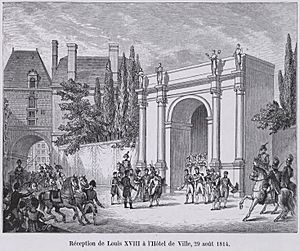
This period was called the Bourbon Restoration. It was marked by conflicts between extreme royalists, who wanted to bring back the absolute monarchy, and liberals, who wanted a stronger constitutional monarchy. Louis XVIII was the younger brother of Louis XVI. He ruled from 1814 to 1824. When he became king, Louis issued a constitution called the Charter. It kept many freedoms gained during the French Revolution. It also created a parliament with an elected Chamber of Deputies and a Chamber of Peers chosen by the king.
Review of the Restoration
After two decades of war and revolution, the restoration brought peace and prosperity. Many historians describe this time as "one of the happiest periods in [France's] history."
France recovered from the disruption of wars and killings. It was peaceful. It paid a large war debt to the winners without trouble. The occupation soldiers left peacefully. The population grew by 3 million. Prosperity was strong from 1815 to 1825. National credit was strong, public wealth increased, and the national budget had a surplus every year. In the private sector, banking grew greatly, making Paris a world financial center. The Rothschild family became famous. Communication improved with better roads, longer canals, and steamboat traffic. Industrialization was slower than in Britain and Belgium. The railway system had not yet appeared. Industry was heavily protected by tariffs, so there was little demand for new ideas.
Culture flourished with new romantic ideas. Debates were of high quality. Châteaubriand and Madame de Staël were famous for romantic literature. De Staël contributed to political and literary sociology. History thrived, with François Guizot and Benjamin Constant learning from the past. The paintings of Eugène Delacroix set standards for romantic art. Music, theater, science, and philosophy also flourished. Higher education thrived at the Sorbonne. New institutions made France a leader in many fields.
Overall, the Bourbon government handled foreign affairs well. France kept a low profile, and Europe forgot its past conflicts. Louis and Charles had little interest in foreign affairs, so France played minor roles. Its army helped restore the Spanish king in 1823. It helped other powers with Greece and Turkey. King Charles X, an extreme conservative, mistakenly thought foreign glory would cover domestic problems. He made a big effort to conquer Algiers in 1830. He sent a huge force of 38,000 soldiers. The expedition was a quick military success, taking only three weeks. The invasion paid for itself with money from the captured treasury. This started the second French colonial empire. But it did not give the King the political support he needed at home. Charles X made internal tensions worse and tried to stop his enemies with harsh measures. He relied too much on his poor chief minister Polignac. His harsh rule failed, and a quick revolution forced Charles into exile for the third time.
July Monarchy (1830–1848)
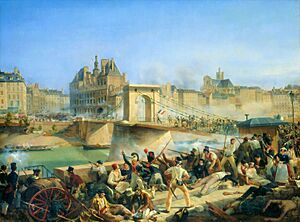
Protests against the absolute monarchy were growing. The elections of 16 May 1830 went very badly for King Charles X. In response, he tried to suppress the protests, but this only made the crisis worse. Suppressed deputies, silenced journalists, students, and many Parisian workers filled the streets and built barricades during the "three glorious days" (Les Trois Glorieuses) of 26–29 July 1830. Charles X was removed from power and replaced by King Louis-Philippe in the July Revolution. This is seen as a rising of the middle class against the Bourbon monarchy. Participants included the Marquis de Lafayette. Louis Adolphe Thiers worked behind the scenes for the wealthy middle class.
Louis-Philippe's "July Monarchy" (1830–1848) was controlled by wealthy bankers, industrialists, and merchants.
During the July Monarchy, the Romantic Era began to flourish. This era created an atmosphere of protest and revolt in France. On 22 November 1831, in Lyon, silk workers revolted and took over the town hall. They were protesting recent salary cuts and working conditions. This was one of the first worker revolts in the world.
Because of constant threats to the throne, the July Monarchy became stricter. Soon, political meetings were outlawed. However, "banquets" were still legal. Throughout 1847, there was a nationwide campaign of republican banquets demanding more democracy. The main banquet was planned for 22 February 1848 in Paris, but the government banned it. In response, citizens of all classes poured into the streets of Paris in revolt. They demanded that "Citizen King" Louis-Philippe step down and that a representative democracy be established. The king abdicated, and the French Second Republic was proclaimed. Alphonse Marie Louis de Lamartine, a leader of moderate republicans, became the Minister of Foreign Affairs and effectively the premier in the new Provisional Government.
Second Republic (1848–1852)
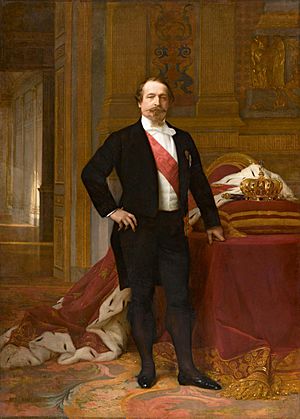
Workers became frustrated when the Constituent Assembly did not address their concerns. Strikes and demonstrations became more common. These reached a peak on 15 May 1848, when workers from secret societies started an armed uprising against the anti-labor and anti-democratic policies of the Assembly. Fearing chaos, the Provisional Government called General Louis Eugene Cavaignac back from Algeria in June 1848 to put down the workers' revolt. From June to December 1848, General Cavaignac led the executive of the Provisional Government.
On 10 December 1848, Louis Napoleon Bonaparte was elected president by a large margin. He had support from many parts of French society for different reasons. Louis Napoleon encouraged this by trying to "be all things to all people." One of his main promises was no new taxes.
The new National Constituent Assembly had many royalist supporters. Because Louis Napoleon's political views were unclear, his plans as president were uncertain. For prime minister, he chose Odilon Barrot, a moderate who had led the opposition under Louis Philippe. Other appointments also represented royalist groups.
The Pope had been forced out of Rome during the Revolutions of 1848. Louis Napoleon sent 14,000 troops under General Nicolas Charles Victor Oudinot to the Papal State to restore him. In April 1849, they were defeated by Giuseppe Garibaldi's volunteers, but then recovered and recaptured Rome.
In June 1849, anti-government demonstrations broke out and were suppressed. Leaders, including politicians, were arrested. The government banned several democratic and socialist newspapers. Karl Marx moved to London.
The government tried to balance its budget and reduce debts. Hippolyte Passy was appointed Finance Minister. In October 1849, Passy proposed an income tax. The middle class, who would pay most of it, protested. The income tax controversy led to Barrot's resignation. A new wine tax also caused protests.
The 1850 elections resulted in a conservative government. It passed the Falloux Laws, which put education in the hands of the Catholic clergy. This started a period of cooperation between Church and state that lasted until 1879. The Falloux Laws provided universal primary schooling and more opportunities for secondary schooling. Catholic and state schools had similar curricula. Catholic schools were especially helpful for girls' education, which had been neglected. A new election law kept universal (male) suffrage but stricter residency rules meant 3 million out of 10 million voters lost their right to vote.
Second Empire (1852–1870)
In 1851, Louis Napoleon was not allowed to seek re-election as President. He declared himself Emperor of the French in 1852, with almost dictatorial powers. He prioritized building a good railway system. He combined many small lines into six major companies centered in Paris. Paris grew greatly in population, industry, finance, and tourism. Napoleon worked with Georges-Eugène Haussmann to rebuild the city into a world-class showpiece. Government guarantees made the railway companies financially sound. By 1870, France had an excellent railway system, supported by good roads, canals, and ports.
Despite promising a peaceful reign in 1852, the Emperor sought glory in foreign affairs. He was visionary but secretive, had poor staff, and often upset his supporters. As a diplomat, he was incompetent. Napoleon had some successes: he strengthened French control over Algeria, set up bases in Africa, began taking over Indochina, and opened trade with China. He helped a French company build the Suez Canal. In Europe, however, Napoleon failed repeatedly. The Crimean War (1854–1856) brought no gains. Napoleon admired Italy and wanted it unified. He planned with Cavour to expel Austria and create an Italian confederation. Events in 1859 got out of his control. Austria was quickly defeated, but popular uprisings united all of Italy under Piedmont instead of four new states. The pope kept Rome only because Napoleon sent troops to protect him. Napoleon's reward was the County of Nice and the Duchy of Savoy. He angered Catholics when the pope lost most of his lands. Napoleon then angered both anti-church liberals and his Italian allies by protecting the pope in Rome.
The British were annoyed by Napoleon's intervention in Syria (1860–1861). Napoleon lowered tariffs, which helped long-term but angered landowners and industrialists short-term. Matters worsened in the 1860s. Napoleon almost went to war with the United States in 1862. His takeover of Mexico (1861–1867) was a total disaster. The puppet emperor he put on the Mexican throne was overthrown and executed. Finally, he went to war with the Germans in 1870, too late to stop German unification. Napoleon had alienated everyone. After failing to get alliances with Austria and Italy, France had no allies and was divided at home. It was disastrously defeated, losing Alsace and Lorraine. Historian A. J. P. Taylor said, "he ruined France as a great power."
Foreign Wars
In 1854, the Second Empire joined the Crimean War, where France and Britain fought the Russian Empire. Russia was defeated at Sevastopol (1854–55) and Inkerman (1854). In 1856, France joined the Second Opium War with Britain against China.
When France was negotiating to buy Luxembourg in 1867, Prussia threatened war. This "Luxembourg Crisis" shocked French diplomats, as there had been an agreement. Napoleon III faced growing criticism from Republicans, and his position seemed weaker.
France interfered in Korea in 1866, gaining little but war spoils. The next year, a French expedition went to Japan to help the Tokugawa shogunate modernize its army. However, Tokugawa was defeated in the Boshin War.
Franco-Prussian War (1870–71)
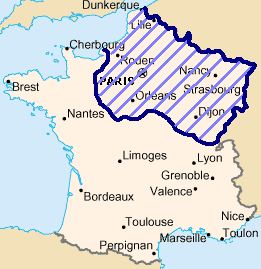
Rising tensions in 1869 over Prince Leopold von Hohenzollern-Sigmaringen's possible claim to the Spanish throne increased hostility between France and Germany. Prince Leopold was part of the Prussian royal family. Spain had asked him to accept the vacant throne.
France could not accept this. Relations worsened, and the Franco-Prussian War (1870–71) broke out. German nationalism united the German states (except Austria) against Napoleon III. The French Empire was decisively defeated at Metz and Sedan. Napoleon III surrendered himself and 100,000 French troops at Sedan on 1–2 September 1870.
Two days later, on 4 September 1870, Léon Gambetta declared a new republic in France. Later, when Paris was surrounded by German troops, Gambetta fled Paris and became the virtual dictator of the war effort from the provinces. Metz remained under siege until 27 October 1870, when 173,000 French troops surrendered. Paris was forced to surrender on 28 January 1871. The Treaty of Frankfurt allowed the new German Empire to take Alsace and Lorraine.
Modernization and Railways (1870–1914)
The lives of French peasants changed quickly from 1870 to 1914. They had been poor and traditional. But railroads, republican schools, and universal military service modernized rural France. The central government in Paris wanted to create a unified nation. It required all students to be taught standard French. This helped create a new national identity.
Railways became a way to modernize traditional regions. Alphonse de Lamartine was a strong supporter. In 1857, an army colonel hoped railways would improve the lives of "populations two or three centuries behind." France built a centralized system radiating from Paris. This design aimed for political and cultural goals, not just efficiency. Six companies controlled monopolies, closely watched by the government.
The central government brought in British engineers, handled construction, and provided expertise. It also subsidized military lines along the German border. Private companies managed operations, hired labor, laid tracks, and built stations. They bought and maintained trains. Much equipment was imported from Britain.
Starting the whole system at once was politically smart, but it delayed completion and relied on temporary British experts. Funding was also a problem. The system helped modernize rural France but did not create local industrial centers. Critics like Émile Zola said it did not overcome political corruption.
Railways likely helped France's industrial revolution by creating a national market for goods. But France's railway goals were more about morality, politics, and military, not just economy. Freight trains were shorter and less loaded than in Britain, Belgium, or Germany. Other infrastructure, like roads and canals, were neglected due to railway costs.
Third Republic and the Belle Époque (1871–1914)
Third Republic and the Paris Commune
After France's defeat in the Franco-Prussian War (1870–71), German Chancellor Otto von Bismarck proposed harsh peace terms, including taking Alsace and Lorraine. A new French National Assembly was elected to consider these terms. Elected on 8 February 1871, this Assembly had 650 members.
Meeting in Bordeaux, the French National Assembly established the Third Republic. However, 400 members were monarchists. Léon Gambetta was one of the Republicans elected from Paris. On 16 February 1871, Adolphe Thiers was elected chief executive of the new Republic. Due to unrest in Paris, the Thiers government was based in Versailles.
In late 1870 and early 1871, Parisian workers had small, unsuccessful uprisings. The National Guard in Paris became defiant. Thiers recognized a revolutionary situation. On 18 March 1871, he sent army units to take control of artillery belonging to the National Guard. Some soldiers joined the rebels, and the revolt grew.
Barricades went up, like in 1830 and 1848. The Paris Commune was born. The Hôtel de Ville (Town Hall) became the center of the revolutionary government. Other French cities, like Lyon, Marseille, and Toulouse, followed Paris's example. But the Thiers government quickly crushed all Communes outside Paris.
An election on 26 March 1871 in Paris created a working-class government. Most delegates were followers of Louis Auguste Blanqui. The minority were anarchists and followers of Pierre Joseph Proudhon. Analysis of arrests showed typical communards opposed the military, clergy, and rural nobles. They saw the middle class as the enemy.
After two months, the French army retook Paris. Battles were fought in working-class neighborhoods. Hundreds were executed, and thousands were sent to Versailles for trials. Perhaps 30,000 were killed during the "Bloody Week" (la semaine sanglante) of 21–28 May 1871. As many as 50,000 were later executed or imprisoned. 7,000 were exiled to New Caledonia. The government's actions were approved in a national vote.
Political Struggles
The Republican government then faced counter-revolutionaries who rejected the 1789 Revolution. Both the Legitimists (supporters of Henri, Count of Chambord, Charles X's grandson) and the Orleanist royalists rejected republicanism. They saw it as modern and anti-religious, breaking with French traditions. This conflict grew sharp in 1873 when Thiers resigned. Marshal Patrice MacMahon became the new president. Amidst rumors of plots by Bonapartists or Bourbons in 1874, the National Assembly began drafting a new constitution acceptable to all.
The new constitution allowed all men to vote. It created a two-chamber legislature: a Senate and a Chamber of Deputies. The early republic was led by pro-royalists. But republicans (the "Radicals") and Bonapartists fought for power. The first election under this constitution in early 1876 resulted in a republican victory.
A coup d'état was always possible. Léon Gambetta chose moderate Armand Dufaure as premier, but he failed to form a government. MacMahon then chose conservative Jules Simon. He also failed, leading to the 16 May 1877 crisis and MacMahon's resignation. A king seemed likely. Royalists agreed on Henri, Count of Chambord. But he demanded France give up its republican tricolour flag and return to the royalist fleur de lys flag. This ruined the royalist cause. The Orleanist faction then supported the Republic. The new President in 1879 was Jules Grevy. In January 1886, Georges Boulanger became Minister of War. This started the Boulanger era, another time of coup threats.
The Legitimist (Bourbon) group mostly left politics. But one part founded L'Action Française in 1898, during the Dreyfus Affair. It became influential among conservative Catholic thinkers until the 1930s.
Social Policies and the Radical Party
In France, liberalism was based on a "solidaristic" idea of society, following the French Revolution's theme of "liberty, equality, fraternity." In the Third Republic (1895-1914), "Solidarism" was the main idea for liberal social policy. Its main supporters were prime ministers Leon Bourgeois and Pierre Waldeck-Rousseau.
From 1879 to 1914, power was mostly held by moderate republicans and "radicals." They avoided state ownership of industry and had a middle-class political base. Their main policies were government help (funded by a progressive income tax) to provide a social safety net. They opposed church schools. They expanded education and promoted cooperatives. In foreign policy, they supported the League of Nations, arbitration, disarmament, and economic sanctions for peace.
The French welfare state grew, following some of Bismarck's policies, starting with aid for the poor.
Foreign Policy
French foreign policy from 1871 to 1914 changed greatly. From a humiliated power with few friends and little empire in 1871, it became central to European alliances by 1914, with a thriving empire second only to Britain's. The Catholic Church focused on missionary work in the colonies. Most French people ignored foreign policy.
French foreign policy was based on fear of Germany, which was larger and growing faster. France also wanted Alsace and Lorraine back. During the Scramble for Africa, French and British interests clashed. The most dangerous event was the Fashoda Incident of 1898. French troops tried to claim an area in Southern Sudan. A British force arrived. Under pressure, the French withdrew, giving Britain control. An agreement recognized British control over Egypt, while France became dominant in Morocco. But France suffered a humiliating defeat.
The Suez Canal, built by the French, became a joint British-French project in 1875. Both saw it as vital for their influence in Asia. In 1882, unrest in Egypt led Britain to intervene. France's leading expansionist, Jules Ferry, was out of office. The government allowed Britain to take control of Egypt.
France had colonies in Asia and sought alliances. Japan was a possible ally. Iwakura Tomomi asked for French help in reforming Japan. French military missions were sent to Japan (1872–1880, 1884–1889, 1918–1919) to modernize its army. Conflicts between China and France over Indochina climaxed during the Sino-French War (1884–1885). Admiral Courbet destroyed the Chinese fleet. The treaty gave France control over northern and central Vietnam.
To isolate Germany, France worked hard to win over Russia and Great Britain. First, with the Franco-Russian Alliance of 1894. Then, the 1904 Entente Cordiale with Great Britain. Finally, the Anglo-Russian Entente in 1907, which became the Triple Entente. This alliance led Russia and Britain to join World War I as France's allies.
The Dreyfus Affair
Distrust of Germany, faith in the army, and French antisemitism led to the Dreyfus Affair. This was the unfair trial and conviction of a Jewish military officer for "treason" in 1894. For a decade, France was divided between "dreyfusards" (supporters of Dreyfus) and "anti-dreyfusards." Far-right Catholic groups made the situation worse, even when proof of Dreyfus's innocence appeared. The writer Émile Zola published an angry editorial (J'Accuse...!) and was convicted of libel. Dreyfus was finally pardoned in 1906. This weakened conservatives in politics. Moderates were divided, allowing the Radicals to hold power from 1899 until World War I. During this time, crises like the threatened "Boulangist" coup (1889) showed the republic's weakness.
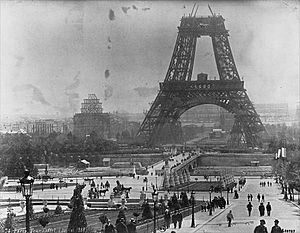
Religion (1870–1924)
Throughout the Third Republic, there were battles over the Catholic Church's status. French clergy and bishops were linked to monarchists. Republicans, mostly anti-church middle-class people, saw the Church's alliance with monarchists as a threat to republicanism and progress. Republicans disliked the church for its political ties and old traditions. Protestants and Jews supported the Republicans. Many laws were passed to weaken the Catholic Church. In 1879, priests were excluded from hospital and charity boards. In 1880, new measures targeted religious groups. From 1880 to 1890, laywomen replaced nuns in many hospitals. Napoleon's 1801 Concordat continued, but in 1881, the government cut salaries for priests it disliked.
The 1882 school laws by Republican Jules Ferry created a national public school system that taught strict morals but no religion. Privately funded Catholic schools were tolerated for a while. Civil marriage became required, divorce was introduced, and chaplains were removed from the army.
When Leo XIII became pope in 1878, he tried to calm Church-State relations. In 1884, he told French bishops not to be hostile to the State. In 1892, he advised French Catholics to support the Republic and defend the Church by joining republican politics. This attempt failed.
Deep suspicions remained and were inflamed by the Dreyfus Affair. Most Catholics were anti-Dreyfusard. The Assumptionists published anti-Jewish and anti-republican articles. This angered Republican politicians, who sought revenge. They often worked with Masonic lodges. The Waldeck-Rousseau Ministry (1899–1902) and the Combes Ministry (1902–1905) fought with the Vatican over bishop appointments. Chaplains were removed from military hospitals (1903–04), and soldiers were told not to go to Catholic clubs (1904). Combes, as Prime Minister in 1902, wanted to defeat Catholicism. He closed all Catholic schools. Then, parliament rejected all religious orders. This meant 54 orders were dissolved, and about 20,000 members left France, many for Spain.
In 1905, the 1801 Concordat was ended. Church and state were separated. All Church property was taken by the state. Public worship was given to Catholic lay groups who controlled access to churches. Masses and rituals continued. The Church was hurt, losing half its priests. But in the long run, it gained independence. Conservative Catholics regained control of Parliament in 1919 and reversed most penalties. Diplomatic relations with the Vatican were restored. However, French society continued to become more secular.
The Belle Époque
The late 19th and early 20th century was called the Belle Époque (Beautiful Era). This was a time of peace, prosperity, and cultural innovations. Artists like Monet and Debussy were famous. Popular entertainment included cabaret, can-can, and cinema. New art movements like Impressionism and Art Nouveau emerged.
In 1889, the Exposition Universelle (World's Fair) showed off modern Paris to the world. People could see it all from the new Eiffel Tower. Meant to last only a few decades, the tower was never removed and became France's most famous landmark.
Despite this, France was divided by ideas, religion, class, and regional differences. Internationally, France often came close to war with other imperial powers, like the 1898 Fashoda Incident with Great Britain over East Africa.
French Colonial Empire
The second colonial empire included overseas colonies, protectorates, and mandate territories under French rule from the 16th century onward. The "first colonial empire" existed until 1814, when most of it was lost. The "second colonial empire" began with the conquest of Algiers in 1830. It ended after losing wars in Vietnam (1954) and Algeria (1962), and through peaceful decolonizations after 1960.
France lost wars to Britain, losing almost all its colonies by 1765. France rebuilt a new empire mostly after 1850, focusing on Africa, Indochina, and the South Pacific. Republicans, initially against empire, only supported it when Germany started building its own colonial empire after 1880. The new empire traded with France, supplying raw materials and buying manufactured goods. It also brought prestige to France and spread French culture and the Catholic religion. It provided soldiers in the World Wars.
It became a moral mission to bring the world up to French standards by spreading Christianity and French culture. In 1884, Jules Ferry, a supporter of colonialism, declared: "The higher races have a right over the lower races, they have a duty to civilize the inferior races." Full citizenship was offered. In reality, French settlers had full rights, and natives had very limited rights. Few settlers permanently moved to the colonies, except for Algeria. Even in Algeria, the "Pied-Noir" (French settlers) remained a small minority.
At its peak, it was one of the largest empires in history. Including France itself, the total land under French rule reached 11.5 million square kilometers in 1920, with 110 million people in 1939. In World War II, the Free French used the overseas colonies as bases to fight for France's liberation. After World War II, France wanted to keep its overseas empire to restore its world power status. Just two days after Nazi Germany's defeat, France suppressed Algerian calls for independence, leading to a massacre where at least 30,000 Muslims died. However, anti-colonial movements gradually challenged European rule. The French Constitution of 27 October 1946 established the French Union, which lasted until 1958. Newer parts of the colonial empire became overseas departments and territories within the French Republic. By the 1970s, the last "remnants of empire held little interest for the French." Except for Algeria's difficult decolonization, giving up the empire had few long-lasting effects on France.
France in the World Wars (1914–1945)
Population Changes
The population stayed steady from 40.7 million in 1911 to 41.5 million in 1936. The idea that the population was too small, especially compared to Germany's rapid growth, was common in the early 20th century. Policies to encourage births were proposed in the 1930s and put in place in the 1940s.
France had a baby boom after 1945, reversing a long period of low birth rates. There was also steady immigration, especially from former French colonies in North Africa. The population grew from 41 million in 1946 to 50 million in 1966 and 60 million by 1990. The farming population dropped sharply, from 35% of workers in 1945 to under 5% by 2000. By 2004, France had the second-highest birthrate in Europe.
World War I
France did not expect war in 1914. But when it came in August, the whole nation rallied for two years. French infantry repeatedly attacked, only to be stopped by German artillery, trenches, and machine guns, with terrible losses. Despite losing major industrial areas, France produced huge amounts of weapons for both French and American armies. By 1917, the infantry was close to mutiny. But they rallied and defeated the biggest German offensive in spring 1918, then pushed back the collapsing invaders. November 1918 brought great pride and a strong desire for revenge.
France paid little attention to foreign policy from 1911–14. It did extend military service to three years in 1913, despite Socialist objections. The rapidly growing Balkan crisis of 1914 caught France off guard. It played a small role in the start of World War I. The Serbian crisis triggered a complex set of military alliances, drawing most of Europe, including France, into war. Austria-Hungary declared war on Serbia in late July, leading to Russian mobilization. On 1 August, Germany and France ordered mobilization. Germany was much better prepared militarily. Germany, as Austria's ally, declared war on Russia. France, allied with Russia, was ready for war against Germany. On 3 August, Germany declared war on France and sent its armies through neutral Belgium. Britain entered the war on 4 August. Italy, though allied with Germany, stayed neutral and joined the Allies in 1915.
Germany's "Schlieffen Plan" aimed to quickly defeat the French. They captured Brussels by 20 August and soon much of northern France. By early September, they were within 65 km of Paris. The French government moved to Bordeaux. The Allies stopped the advance northeast of Paris at the Marne River (5–12 September 1914).
The war became a stalemate. The famous "Western Front" was fought mostly in France. It saw little movement despite huge, violent battles, often with new, destructive weapons. Trenches grew deeper and more complex, becoming vast defensive networks. The war of movement turned into a war of position. Neither side advanced much, but both suffered hundreds of thousands of casualties. German and Allied armies created matching trench lines from Switzerland to the North Sea. Large parts of northeastern France came under harsh German control.
Trench warfare dominated the Western Front from September 1914 to March 1918. Famous battles in France include Battle of Verdun (10 months, 1916), Battle of the Somme (1916), and five Battles of Ypres (1914–1918).
After Socialist leader Jean Jaurès, a pacifist, was killed at the war's start, the French socialist movement joined the war effort. Prime Minister René Viviani called for unity—a "Union sacrée" ("Sacred Union")—a wartime truce between warring political factions. France had few dissenters. However, war-weariness was strong by 1917, even in the army. Soldiers were reluctant to attack, with many saying it was best to wait for American troops. They protested not just the futility of frontal assaults but also poor conditions at the front, infrequent leaves, bad food, and concerns for their families.
After defeating Russia in 1917, Germany focused on the Western Front. They planned a big attack in spring 1918, before the American army grew too large. In March 1918, Germany launched its offensive and by May was again near Paris. However, in the Second Battle of the Marne (15 July to 6 August 1918), the Allied line held. The Allies then attacked. The Germans, out of reinforcements, were overwhelmed. Austria and Turkey collapsed, and the Kaiser's government fell. Germany signed "The Armistice" ending fighting on 11 November 1918.
Wartime Losses
The war was largely fought on French soil. France had 3.4 million dead, including civilians, and four times as many military casualties. The economy was hurt by the German invasion of industrial areas. The occupied area, though only 14% of France's industrial workers in 1913, produced 58% of steel and 40% of coal. In 1914, the government controlled the economy and rationed goods. By 1915, the war economy was in full swing, with millions of French women and colonial men replacing soldiers. American food, money, and raw materials helped greatly in 1917. This war economy had lasting effects, as it was a first step away from free-market ideas. War damages were about 113% of the 1913 GDP, mainly destroyed capital and housing. National debt rose from 66% of GDP in 1913 to 170% in 1919. Inflation was severe, and the franc lost over half its value.
The richest families were hurt. The top 1 percent's share of wealth dropped from about 60% in 1914 to 36% in 1935, then to 20% by 1970. Much physical and financial damage occurred during the world wars. Foreign investments were sold to pay for wars. Russian Bolsheviks took large investments. Postwar inflation destroyed cash holdings. Stocks and bonds fell during the Great Depression. Progressive taxes reduced accumulated wealth.
Postwar Settlement
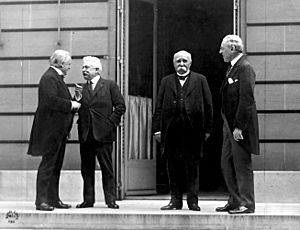
Peace terms were set by the Big Four in Paris in 1919: David Lloyd George (Britain), Vittorio Orlando (Italy), Georges Clemenceau (France), and Woodrow Wilson (United States). Clemenceau demanded the harshest terms and got most of them in the Treaty of Versailles in 1919. Germany was forced to admit guilt for starting the war and was weakened militarily. Germany had to pay huge amounts in war reparations to the Allies.
France regained Alsace-Lorraine and occupied the German industrial Saar Basin. German African colonies were placed under League of Nations mandates, managed by France and other victors. From the Ottoman Empire, France gained the Mandate of Syria and the Mandate of Lebanon. French Marshal Ferdinand Foch wanted peace that would prevent Germany from ever threatening France again. After the Treaty of Versailles was signed, he said, "This is not a peace. It is an armistice for 20 years."
Between the Wars: Foreign Policy and Depression
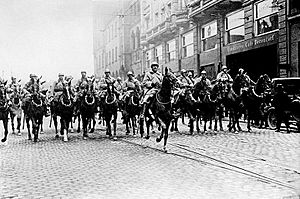
France was part of the Allied force that occupied the Rhineland after the Armistice. Foch supported Poland in the Greater Poland Uprising and the Polish–Soviet War. France also joined Spain in the Rif War. From 1925 until his death in 1932, Aristide Briand, as Prime Minister during five short periods, led French foreign policy. He used his diplomatic skills to build friendly relations with Weimar Germany for peace within the League of Nations. He knew France could not contain Germany alone or get enough support from Britain or the League.
When Weimar Germany failed to pay war reparations, France occupied the industrial Ruhr region to ensure payments. This failed, and France accepted the American solution for reparations, the Dawes Plan and the Young Plan.
In the 1920s, France built the Maginot Line, a strong border defense system against German attack. The Line did not extend into Belgium, which Germany exploited in 1940. Military alliances were signed with weaker powers in 1920–21, called the "Little Entente".
The Great Depression affected France later than other countries, around 1931. While GDP grew strongly in the 1920s (4.43% per year), it fell to only 0.63% in the 1930s. The depression was mild: unemployment peaked under 5%, production fell at most 20% below 1929 levels, and there was no banking crisis.
However, the political upheaval was huge. Socialist Leon Blum, leading the Popular Front, became Prime Minister from 1936 to 1937. He was the first Jewish and first Socialist leader of France. Communists in the Chamber of Deputies supported the government's economic policies but rejected its foreign policies. The Popular Front passed many labor reforms: increased wages, 40-hour work weeks, and two-week paid vacations. But inflation canceled wage gains, unemployment did not fall, and economic recovery was slow. The Popular Front failed in economics, foreign policy, and stability. It created excitement but did not live up to its promise. However, Socialists later drew inspiration from its attempts to create a welfare state.
The government joined Britain in an arms embargo during the Spanish Civil War (1936–1939). Blum refused to support the Spanish Republicans, fearing civil war might spread to France. Financial and military cooperation with Poland was also a policy. The government nationalized arms suppliers and greatly increased military rearmament to catch up with Germany.
Appeasement of Germany, with Britain, was the policy after 1936. France sought peace despite Hitler's demands. Prime Minister Édouard Daladier refused to go to war without British support, as Neville Chamberlain wanted to save peace at Munich in 1938.
World War II

Germany's invasion of Poland in 1939 finally led France and Britain to declare war. But the Allies did not launch big attacks. This was called the Phoney War in Britain or Drôle de guerre (funny war) in France. It did not stop the German army from conquering Poland quickly with its new Blitzkrieg tactics.
When Germany was ready to attack in the west, the Battle of France began in May 1940. The same Blitzkrieg tactics were devastating. The Wehrmacht bypassed the Maginot Line by going through the Ardennes forest. Another German force went into Belgium and the Netherlands as a diversion. In six weeks of fierce fighting, the French lost 90,000 men.
Many civilians fled. About 2 million refugees from Belgium and the Netherlands, joined by 8 to 10 million French civilians (a quarter of France's population), headed south and west. This might have been the largest civilian movement in history before 1947.
Paris fell to the Germans on 14 June 1940. But the British Expeditionary Force and many French soldiers were evacuated from Dunkirk.
Vichy France was set up on 10 July 1940 to govern the unoccupied part of France and its colonies. It was led by Philippe Pétain, a World War I hero. Petain's representatives signed a harsh Armistice on 22 June 1940. Germany kept most French soldiers in camps and demanded large payments in gold and food. Germany occupied three-fifths of France, leaving the rest to the new Vichy government. However, local government was mostly handled by traditional French officials. In November 1942, all of Vichy France was occupied by German forces. Vichy continued but was closely watched by the Germans.
The Vichy regime tried to work with Germany, keeping peace in France to avoid more occupation. But this came at the cost of personal freedom. About 76,000 Jewish people were deported during the German occupation, often with Vichy's help, and murdered in Nazi camps.
The Resistance
General Charles de Gaulle in London declared himself head of a rival government in exile. He gathered the Free French Forces, finding support in some French colonies and recognition from Britain. After the Attack on Mers-el-Kébir in 1940, where the British fleet destroyed much of the French navy (still under Vichy command), there was widespread anger and distrust in French forces. Eventually, several important French ships joined the Free French Forces. The United States kept diplomatic ties with Vichy and did not recognize de Gaulle as the sole government of France.
Inside France, the organized underground grew as Vichy became stricter and Nazi Germany weakened. They formed the Resistance. Increasing repression led to the destruction of the village of Oradour-sur-Glane during the Battle of Normandy. On 10 June 1944, SS troops entered Oradour-sur-Glane. They gathered most of the villagers into barns and the church, then massacred 642 civilians.
In 1953, 21 men were tried for the Oradour killings. Fourteen were French citizens from Alsace. All but one were pardoned by the French government.
On 6 June 1944, the Allies landed in Normandy. On 15 August, Allied forces landed in Provence, including 260,000 men of the French First Army. German lines broke, and they fled back to Germany, though keeping control of major ports. Allied forces liberated France. The Free French were given the honor of liberating Paris in late August 1944. The French army recruited French Forces of the Interior (Resistance fighters) to continue the war. This army grew to 300,000 men by September 1944 and 370,000 by spring 1945.
The Vichy regime fell apart. An interim Provisional Government of the French Republic was quickly set up by de Gaulle. This government, called the GPRF, was an alliance of communists, socialists, and democratic republicans. The GPRF ruled France from 1944 to 1946, then was replaced by the French Fourth Republic. Tens of thousands of collaborators were executed without trial. The new government declared Vichy laws illegal and elected new local governments. Women gained the right to vote.
France Since 1945
The political scene in 1944–45 was controlled by the Resistance, but it had many groups. Charles de Gaulle and the Free France element, based outside France, now dominated. They allied with Socialists, Christian Democrats, and what remained of the Radical party. Communists had largely dominated the Resistance inside France but worked closely with the government. There was a general agreement that important companies that had worked with the Germans should be nationalized, like Renault cars and major newspapers. A new Social Security system was called for, and new benefits for labor unions. Unions themselves were divided. Frustrated by his inability to control all forces, de Gaulle resigned in early 1946. On 13 October 1946, a new constitution established the Fourth Republic. It was a parliamentary government controlled by coalitions. France tried to regain control of French Indochina but was defeated by the Viet Minh in 1954. Months later, France faced another anti-colonialist conflict in Algeria. The debate over keeping control of Algeria, home to over a million European settlers, tore the country apart and almost led to a coup and civil war. Charles de Gaulle managed to keep the country together while working to end the war. The Algerian War ended with the Évian Accords in 1962, leading to Algerian independence.
Economic Recovery After WWII
Wartime damage to the economy was severe. France lacked resources to recover alone. The transportation system was destroyed—Allies bombed railways and bridges, Germans destroyed ports. Energy was scarce. Imports of raw materials were cut off, so most factories closed. Invaders took valuable industrial tools for German factories. Discussions with the U.S. for aid were slow. Meanwhile, millions of French prisoners and forced laborers returned home, with few jobs or food. The plan was for France to get 20% of German reparations, but Germany was in worse shape.
After de Gaulle left office in January 1946, American aid began. The U.S. Army shipped food from 1944 to 1946. U.S. Treasury loans and grants were given from 1945 to 1947, with Marshall Plan aid until 1951. France received more aid from 1951 to 1955 to rearm and fight in Indochina. Most funds were grants, not loans. World War I debts were renegotiated in the Blum-Byrnes agreement of 1946. The U.S. forgave all $2.8 billion in WWI debt and gave France a new $650 million loan. In return, French negotiator Jean Monnet presented France's five-year recovery plan. The Marshall Plan gave France $2.3 billion with no repayment. Total U.S. aid to France from 1946 to 1953 was $4.9 billion.
A key part of the Marshall Plan was to encourage international trade, reduce tariffs, and modernize French management. France sent 500 missions with 4,700 businessmen and experts to tour American factories, farms, and offices. They were impressed by American workers' prosperity. Some French businesses resisted Americanization, but profitable ones (chemicals, oil, electronics) took the chance to attract U.S. investments. The U.S. insisted on opportunities for Hollywood films, and the French film industry revived.
Though France's economy was grim in 1945, resources existed, and growth returned by the 1950s. France regained its international status thanks to a successful production strategy, population growth, and new ideas. Conditions varied by company. Some were destroyed or nationalized, but most continued, sometimes working harder. Industries were reorganized with mixed results. Despite U.S. pressure, there was little change in French industrial management training.
The Monnet Plan provided a clear economic policy, strongly supported by the Marshall Plan. It was based on moderate, free-trade ideas, not state control. The French economy was as productive as other Western European countries.
Claude Fohlen argues that France received $7 billion, used to finance imports and the Monnet Plan. Without the Marshall Plan, recovery would have been much slower. This growth was also affected by decolonization.
Vietnam and Algeria
Pierre Mendès France, a Radical party leader, was Prime Minister for eight months in 1954–55. He had Socialist and Communist support. His top priority was ending the war in Indochina, which had cost 92,000 dead and many wounded and captured after the defeat at the Battle of Dien Bien Phu. The U.S. paid most war costs, but French support for the war collapsed. Polls in February 1954 showed only 7% of French people wanted to continue fighting to keep Indochina from Communists. At the Geneva Conference in July 1954, Mendès France made a deal giving Ho Chi Minh's Viet Minh control of North Vietnam. France pulled out all its forces, leaving South Vietnam alone. The U.S. then provided large financial and military support to South Vietnam. Mendès-France next agreed with Habib Bourguiba, Tunisia's nationalist leader, for Tunisia's independence by 1956. He also began talks with nationalist leaders in Morocco for French withdrawal.
With over a million European residents in Algeria (the Pieds-Noirs), France refused to grant independence until the Algerian War of Independence caused a French political and civil crisis. Algeria gained independence in 1962. This led to a massive wave of immigration back to France of both Pieds-Noirs and Algerians who had supported France.
Suez Crisis (1956)
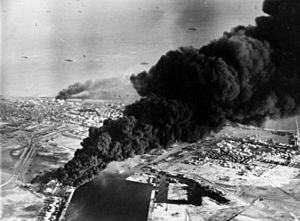
In 1956, another crisis hit French colonies, this time in Egypt. The Suez Canal, built by the French government, belonged to France and was operated by the Suez Canal Company. Great Britain was the second-largest owner.
Egyptian President Gamal Abdel Nasser nationalized the canal despite French and British opposition. He thought a European response was unlikely. Britain and France attacked Egypt, forming an alliance with Israel against Nasser. Israel attacked from the east, Britain from Cyprus, and France from Algeria. Egypt was defeated in a few days. The Suez crisis caused anger in the Arab world, and Saudi Arabia put an oil embargo on France and Britain. U.S. President Dwight D. Eisenhower forced a ceasefire. Britain and Israel soon withdrew, leaving France alone in Egypt. Under strong international pressure, the French government eventually pulled its troops from Suez and largely left the Middle East.
President de Gaulle (1958–1969)
The May 1958 takeover of power in Algiers by French army units and settlers, who opposed giving in to Arab nationalists, shattered the unstable Fourth Republic. The National Assembly brought De Gaulle back to power during this crisis. He founded the Fifth Republic with a stronger presidency and was elected president. He kept France together while ending the war, despite anger from the Pieds-Noirs (French settlers in Algeria) and the military, who had supported his return to maintain colonial rule. He granted independence to Algeria in 1962 and gradually to other French colonies.
De Gaulle declared grandeur (greatness) essential for France. He started his "Politics of Grandeur." He demanded complete independence for France in world affairs, meaning major decisions could not be forced by NATO or the European Community. De Gaulle pursued "national independence." He vetoed Britain's entry into the Common Market, fearing it would gain too much influence. While not officially leaving NATO, he withdrew from its military command, fearing U.S. control. He launched an independent nuclear development program, making France the fourth nuclear power. France adopted the dissuasion du faible au fort doctrine, meaning a Soviet attack on France would bring total destruction to both sides.
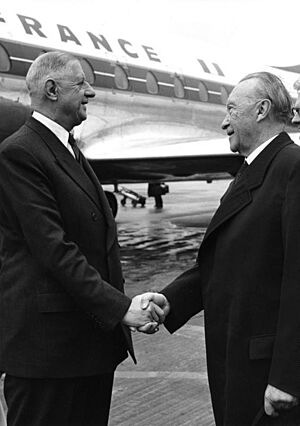
He restored friendly Franco-German relations to create a European balance between the "Anglo-Saxon" (American and British) and Soviet influences. De Gaulle openly criticized the U.S. intervention in Vietnam. He was angry at American economic power, especially what his Finance minister called the "exorbitant privilege" of the U.S. dollar. He went to Canada and proclaimed "Vive le Québec libre" (Long live free Quebec), a slogan for an independent Quebec.
In May 1968, he seemed likely to lose power amidst widespread student and worker protests. But he survived the crisis with army support. His party, denouncing radicalism, won the 1968 election with an increased majority. However, de Gaulle resigned in 1969 after losing a referendum where he proposed more decentralization. His War Memoirs became a classic of modern French literature, and many French political groups claim his legacy.
Economic Challenges (1970s-1980s)
By the late 1960s, France's strong economic growth was slowing. A global currency crisis led to a devaluation of the Franc against the West German Mark and the U.S. Dollar in 1968. This was a major factor in the social unrest of that year. Industrial policy was used to support French industries.
The Trente Glorieuses (Thirty Glorious Years) era (1945–1975) ended with the worldwide 1973 oil crisis. This increased energy costs and production costs. Economic instability marked the Giscard d'Estaing government (1974–1981). Giscard turned to Prime Minister Raymond Barre in 1976, who proposed strict policies ("Barre Plans"). The first plan, on 22 September 1976, aimed to stop inflation. It included a three-month price freeze, reduced value-added tax, wage and salary controls, reduced money supply growth, and increased income, car, luxury, and bank taxes. Measures were taken to restore trade balance and support economic growth and employment. Oil imports were limited. There was special aid for exports and industries. Farmers received more financial aid due to drought, and social security was increased. The plan was unpopular but pursued vigorously.
Economic troubles continued into the early years of François Mitterrand's presidency. A recession in the early 1980s led to abandoning state control in favor of a more practical economic approach. Growth resumed later in the decade, only to be slowed by the early 1990s economic depression, which affected the Socialist Party. Liberalization under Jacques Chirac in the late 1990s strengthened the economy. However, after 2005, the world economy stagnated. The 2008 global crisis affected the conservative government of Nicolas Sarkozy, who lost reelection in 2012 to Socialist Francois Hollande.
France's recent economic history has been less turbulent than many other countries. The average income in France, after being steady for a long time, increased elevenfold between 1700 and 1975. This was a 0.9% growth rate per year, a rate that has been surpassed almost every year since 1975. By the early 1980s, wages in France were at or slightly above the European Economic Community average.
From 1989 to the Early 21st Century
After the fall of the USSR and the end of the Cold War, threats to mainland France seemed much smaller. France began reducing its nuclear weapons, and military conscription was abolished in 2001. In 1990, France, led by François Mitterrand, joined the successful Gulf War against Iraq. French participation was called Opération Daguet.
Terrorism became a bigger concern. In 1994, Air France Flight 8969 was hijacked by terrorists, who were captured.
Conservative Jacques Chirac became president on 17 May 1995. His campaign focused on fighting France's high unemployment. While France values its history and independence, French leaders increasingly link France's future to the European Union. In 1992, France approved the Maastricht Treaty, which created the European Union. In 1999, the Euro replaced the French franc. Besides the EU, France is involved in many joint European projects like Airbus, the Galileo positioning system, and the Eurocorps.
The French have been strong supporters of NATO and EU policy in the Balkans to prevent genocide in former Yugoslavia. French troops joined the 1999 NATO bombing of the Federal Republic of Yugoslavia. France has also been active against international terrorism. In 2002, Alliance Base, an international Counterterrorist Intelligence Center, was secretly set up in Paris. That same year, France helped in the toppling of the Taliban regime in Afghanistan. But it strongly opposed the 2003 invasion of Iraq, even threatening to veto the U.S. resolution.
Jacques Chirac was reelected in 2002, mainly because his socialist rival Lionel Jospin was eliminated by far-right candidate Jean-Marie Le Pen. Chirac was known for strongly opposing the U.S. invasion of Iraq in 2003. Conservative Nicolas Sarkozy was elected and took office on 16 May 2007. The problem of high unemployment remains. Sarkozy was very active in the military operation in Libya to remove the Gaddafi government in 2011.
In the 2012 presidential election, Socialist François Hollande defeated Sarkozy. Hollande supported a growth policy, unlike Germany's Angela Merkel who advocated austerity to tackle the European sovereign debt crisis. In 2014, Hollande joined Merkel and U.S. President Obama in imposing sanctions on Russia for its actions against Ukraine. In December 2016, Hollande announced he would not seek re-election.
In the 2017 presidential election, Emmanuel Macron won. He founded a new party, "La République En Marche!", which claimed to be beyond left and right. He called parliamentary elections, winning an absolute majority. He appointed a prime minister from the center-right and ministers from both center-left and center-right.
In the 2022 presidential election, President Macron was re-elected after defeating his far-right rival, Marine Le Pen. He was the first incumbent French president to be re-elected since 2002.
Sophie Meunier in 2017 wondered if France is still important in world affairs. She noted that France's global influence has decreased since decolonization. Other countries gained nuclear weapons and built armies. France's message of "universal" values faced resistance as other countries developed differently. By the 1990s, France became an "ordinary power." Public opinion, especially in the U.S., no longer sees France as essential. The last time its foreign policy put France in the spotlight was its refusal to join the U.S.-led coalition in Iraq. However, France is still militarily important. France also showed its importance in environmental affairs with the Paris Agreement to reduce carbon emissions. Trump's election in 2016 might increase demands for France to lead global environmental governance if the U.S. withdraws.
Images for kids
See also
 In Spanish: Historia de Francia para niños
In Spanish: Historia de Francia para niños





